Paul van Yperen's Blog, page 277
March 23, 2018
Fotocelere
Several of the postcards of the divas of the Italian silent cinema were published by a company in Torino (Turin), Fotocelere. From 1908 on, Fotocelere published thousands of postcards in a wide range of genres This post focuses on Fotocelere's early postcards of the Italian divas of the 1910's and early 1920s.
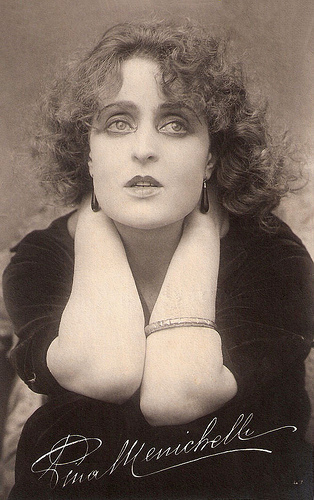
Pina Menichelli . Italian postcard by Fotocelere, Torino.
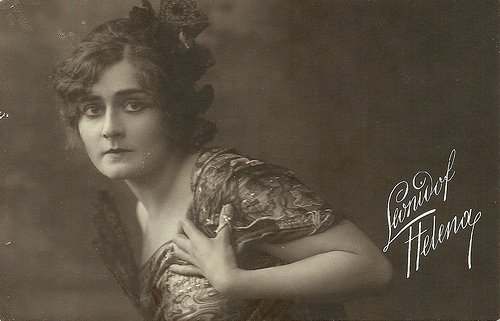
Ileana Leonidoff . Italian postcard by Fotocelere, Torino.
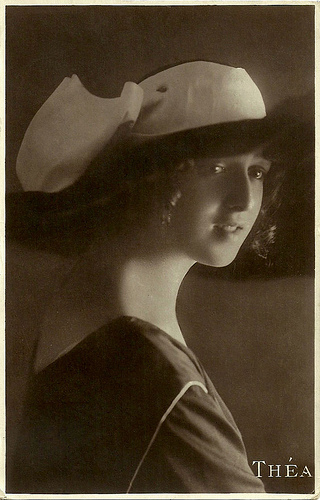
Thea . Italian postcard by Fotocelere, Torino.
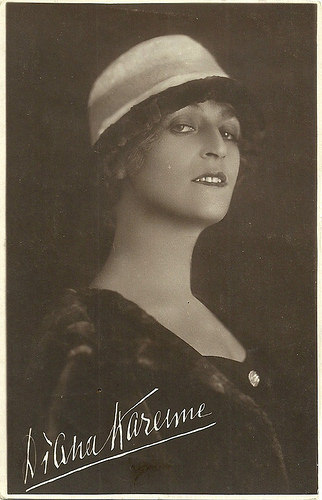
Diana Karenne . Italian postcard by Fotocelere, Torino.
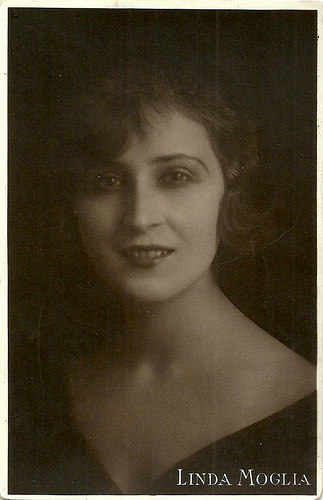
Linda Moglia . Italian postcard by Fotocelere, Torino.
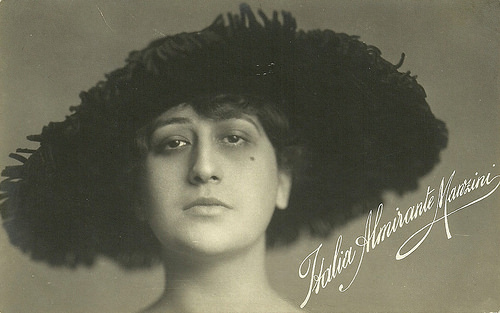
Italia Almirante Manzini . Italian postcard by Fotocelere, Torino.
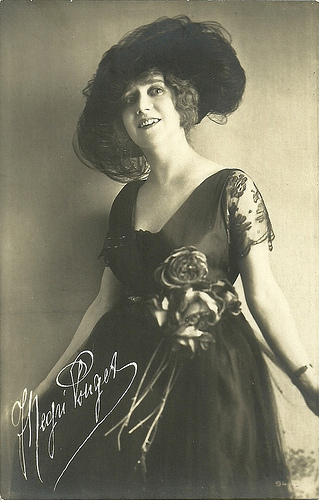
Fernanda Negri Pouget . Italian postcard by Fotocelere, Torino.
Compagnia Fotocelere
Fotocelere (Compagnia Fotocelere) was a photography studio and graphic art and silver bromide photograph printing company in Torino, Turin, Italy.
It was founded in 1908 by Mariano De Sperati (Desperati) at via Madama Cristina, 26. He also founded a similar company in Turin, L'Argentografica.
In 1910, De Sperati went into partnership with Angelo Campassi at via Marocchetti, 4 to produce commercial photographic art and silver bromide postcards, which between 1917 and 1942 were published under the name Fotocelere di A. Campassi, when Campassi was sole owner of the company.
In 1917, after returning from fighting in the First World War, De Sperati revived the L'Argentografica business and began to print postcards.
Fotocelere di A. Campassi published real photograph postcards in a wide range of genres, especially views of Italian cities, which were taken by a number of photographers.

Linda Moglia . Italian postcard by Fotocelere, Torino, no. 80.
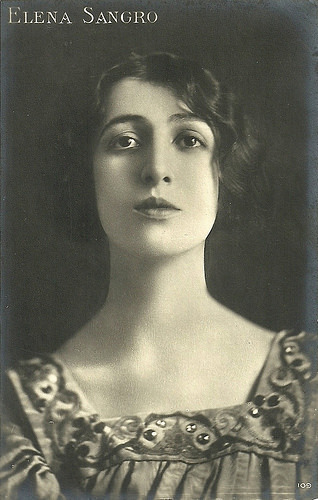
Elena Sangro . Italian postcard by Fotocelere, Torino, no. 109.
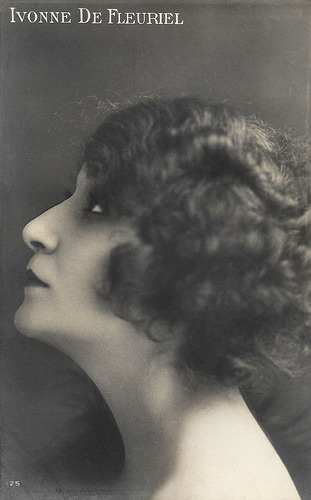
Yvonne de Fleuriel . Italian postcard by Fotocelere, Torino, no. 125.
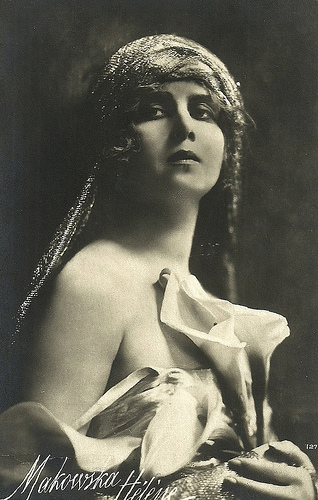
Helena Makowska . Italian postcard by Fotocelere, Torino, no. 127.
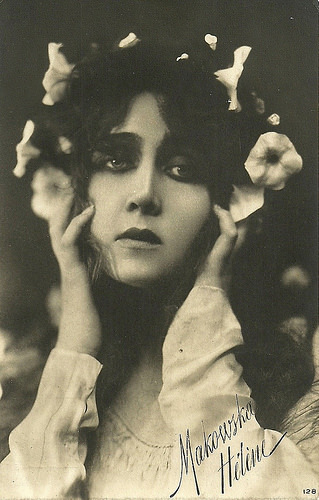
Helena Makowska . Italian postcard by Fotocelere, Torino, no. 128.
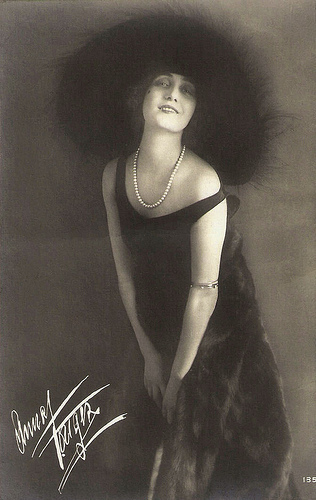
Anna Fougez . Italian postcard by Fotocelere, no. 135.
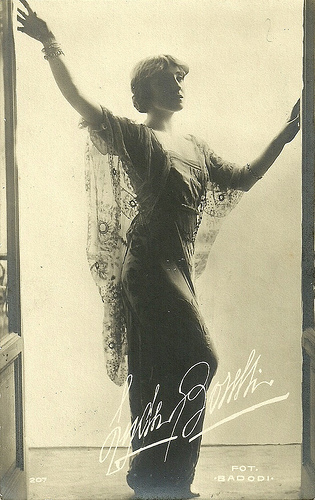
Lyda Borelli . Italian postcard by Fotocelere, Torino, no. 207. Photo: Badodi, Milano.

Francesca Bertini . Italian postcard by Fotocelere, Torino, no. 324.
Source: .

Pina Menichelli . Italian postcard by Fotocelere, Torino.

Ileana Leonidoff . Italian postcard by Fotocelere, Torino.

Thea . Italian postcard by Fotocelere, Torino.

Diana Karenne . Italian postcard by Fotocelere, Torino.

Linda Moglia . Italian postcard by Fotocelere, Torino.

Italia Almirante Manzini . Italian postcard by Fotocelere, Torino.

Fernanda Negri Pouget . Italian postcard by Fotocelere, Torino.
Compagnia Fotocelere
Fotocelere (Compagnia Fotocelere) was a photography studio and graphic art and silver bromide photograph printing company in Torino, Turin, Italy.
It was founded in 1908 by Mariano De Sperati (Desperati) at via Madama Cristina, 26. He also founded a similar company in Turin, L'Argentografica.
In 1910, De Sperati went into partnership with Angelo Campassi at via Marocchetti, 4 to produce commercial photographic art and silver bromide postcards, which between 1917 and 1942 were published under the name Fotocelere di A. Campassi, when Campassi was sole owner of the company.
In 1917, after returning from fighting in the First World War, De Sperati revived the L'Argentografica business and began to print postcards.
Fotocelere di A. Campassi published real photograph postcards in a wide range of genres, especially views of Italian cities, which were taken by a number of photographers.

Linda Moglia . Italian postcard by Fotocelere, Torino, no. 80.

Elena Sangro . Italian postcard by Fotocelere, Torino, no. 109.

Yvonne de Fleuriel . Italian postcard by Fotocelere, Torino, no. 125.

Helena Makowska . Italian postcard by Fotocelere, Torino, no. 127.

Helena Makowska . Italian postcard by Fotocelere, Torino, no. 128.

Anna Fougez . Italian postcard by Fotocelere, no. 135.

Lyda Borelli . Italian postcard by Fotocelere, Torino, no. 207. Photo: Badodi, Milano.

Francesca Bertini . Italian postcard by Fotocelere, Torino, no. 324.
Source: .
Published on March 23, 2018 23:00
March 22, 2018
Special David di Donatello Award for Stefania Sandrelli
On 21 March 2018, Stefania Sandrelli (1946) received the special prize at the 62nd edition of the David di Donatello awards, the Italian equivalent of the Oscars. She received the statuette by TV host Carlo Conti, and according to Italian media she was moved, almost to tears. The sensual, vivacious and very talented Italian actress is famous for her roles in the Commedia all'Italiana. She was 15 years old when she had her breakthrough opposite Marcello Mastroianni in the Oscar winning comedy Divorzio all'italiana/Divorce, Italian Style (1961). Later she also played dramatic roles in Italian classics like Ettore Scola's C'eravamo tanto amati, and Bernardo Bertolucci’s Il Conformista/The Conformist (1970) and Novecento/1900 (1976).
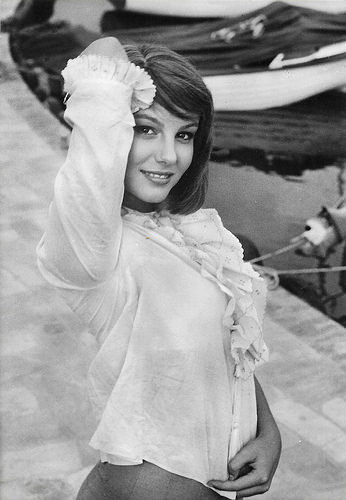
Italian postcard by Alterocca, Terni, no. 64121. Photo: A. Frontoni. Publicity still for La Bella di Lodi/The Beauty of Lodi (Mario Missiroli, 1963).

Romanian postcard by Casa Filmului Acin.
Divorce, Italian Style
Stefania Sandrelli was born in Viareggio, Tuscany, into a middle-class family, in 1946. She was the daughter of Florida and Otello Sandrelli, owners of a well known pension in Viareggio. Her father died when Stefania was eight years old. She has a brother, Sergio, seven years older, who had a successful music career and died in 2013.
At a young age she learned to play the accordion, and studied ballet. In 1960 Sandrelli won the Miss Cinema Viareggio beauty contest. Next she was the cover girl of the magazine Le Ore and made her cinema debut in Gioventù di note/Youth at night (Mario Sequi, 1961) with Samy Frey and Magali Noël . Her second role was as a confidence trickster and petty thief in the war film Il federale/The Fascist (Luciano Salce, 1961), starring Ugo Tognazzi .
Her film career was definitively launched when she appeared as Marcello Mastroianni 's seductive, young cousin, Angela in Divorzio all'italiana/Divorce, Italian Style (Pietro Germi, 1961). The film won an Oscar for Best Original Script. With director Pietro Germi she later worked three more times: in the dark satire of Sicilian social customs and honour laws Sedotta e abbandonata/Seduced and Abandoned (1963), the comedy L'immorale/The Immoralist (1967) featuring Ugo Tognazzi , and Alfredo, Alfredo (1970) with Dustin Hoffman.
Stefania Sandrelli became in a short time a protagonist of the Commedia all'italiana. She was excellent as a lonely, sickly country woman trying to survive in a hostile post-WW II city in Io la conoscevo bene/I Knew Her Well (Antonio Pietrangeli's, 1965) with Mario Adorf . In France, she appeared in the box office hit Tendre Voyou/Tender Scoundrel (Jean Becker, 1966), starring Jean Paul Belmondo . For her role in L'amante di Gramigna/The Bandit (Carlo Lizzani, 1969), Sandrelli was awarded as Best Actress at the San Sebastián International Film Festival.
Throughout the 1970s, Sandrelli continued to be one of the stars of the Commedia all'italiana. She appeared in Mario Monicelli's Brancaleone alle crociate/Brancaleone at the Crusades (1970) with Vittorio Gassman and Adolfo Celi, in Ettore Scola's C'eravamo tanto amati/We All Loved Each Other So Much (1974) with Gassman and Nino Manfredi, and in the satirical comedy-drama L'ingorgo - Una storia impossibile/Traffic Jam (Luigi Comencini, 1979). She also starred in several dramatic films, such as Delitto d'amore/Somewhere Beyond Love (Luigi Comencini, 1974) with Giuliano Gemma .
Sandrelli worked several times with prolific director Bernardo Bertolucci, and starred in his dramas Partner (1968) opposite Pierre Clémenti, Il Conformista/The Conformist (1970) as the wife of Jean-Louis Trintignant , and Novecento/1900 (1976), as the wife of Gérard Dépardieu . She also played in French productions, such as Les Magiciens'/Death Rite (Claude Chabrol, 1976) with Franco Nero , and the crime-thriller Police Python 357/The Case Against Ferro (Alain Corneau, 1976) starring Yves Montand and Simone Signoret . In 1980 she won the Nastro d'Argento for Best Supporting Actress for her performance in Ettore Scola's La terrazzo/The terrace (1980).

Small Czech collectors card by Pressfoto, Praha (Prague), 1965, no. S 83/6. Publicity still for Divorzio all'italiana/Divorce, Italian Style (Pietro Germi, 1961) with Marcello Mastroianni .

Romanian postcard by Casa Filmului Acin.

Italian postcard by Il Museo Nazionale del Cinema, Torino.
The Key
After some less successful films, Stefania Sandrelli relaunched her career with the erotic film La chiave/The Key (Tinto Brass, 1983), based on the novel Kagi by Jun'ichirō Tanizaki. The film caused some scandal because of the explicit nude scenes in which Sandrelli was involved and obtained a great commercial success. In the wake of the success of La Chiave, she played in a brief series of successful erotic films. She also continued to appear in dramas like Segreti segreti/Secrets Secrets (Giuseppe Bertolucci, 1985) and the courtroom drama Mamma Ebe/Mother Ebe (Carlo Lizzani, 1985).
One of her best films of this decade was the comedy Speriamo che sia femmina/Let's Hope It's a Girl (Mario Monicelli, 1986), starring Liv Ullman and Catherine Deneuve . For this film Sandrelli was awarded with a David di Donatello for Best Supporting Actress. The film also won the David di Donatello for Best Film, Best Director, Best Supporting Actor, Best Producer, Best Editing and Best Script. Another award winning film was La famiglia/The Family (Ettore Scola, 1987) in which she starred with Vittorio Gassman , Fanny Ardant and Philippe Noiret .
Sandrelli was nominated to the Nastro Argento (Silver Ribbon award) for Best Actress for her role in the historical comedy-drama Secondo Ponzio Pilato (Luigi Magni, 1987), an ironic reinterpretation of the history, starring Nino Manfredi as Pontius Pilate. She won again a David di Donatello for Best Actress for the drama Mignon è partita/Mignon Has Come to Stay (Francesca Archibugi, 1988). The film won another four David di Donatello awards. A popular success was the comedy Il piccolo diavolo/The Little Devil (1988) directed by and starring Roberto Benigni. She also starred opposite Giancarlo Giannini and Emmanuelle Seigner in the drama Il male oscuro/Dark Illness (Mario Monicelli, 1990).
In the following decade, the Italian film industry got into a crisis and Italian films in general were less prolific than they used to be. Sandrelli appeared in TV series and in international productions like the romantic drama Die Rückkehr/The African Woman (Margarethe von Trotta, 1990) with Barbara Sukowa and Samy Frey , the Spanish comedy/drama Jamón Jamón/Ham, Ham (Bigas Luna, 1992), starring Javier Bardem and Penélope Cruz, and the Argentine-American drama De amor y de sombras/Of Love and Shadows (Betty Kaplan, 1994), based on the novel by Isabel Allende and starring Antonio Banderas and Jennifer Connelly.
She played a supporting part in Bertolucci’s Io ballo da sola/Stealing Beauty (Bernardo Bertolucci, 1996) starring Liv Tyler and Joseph Fiennes. That year she also appeared in the comedy-drama Ninfa plebea/The Nymph (Lina Wertmüller, 1996) with Raoul Bova. She won another the Nastro d'Argento for Best Supporting Actress for the Commedia all'italiana La cena/The Dinner (Ettore Scola, 1998). In Portugal, she appeared in Um Filme Falado/A Talking Picture (2003), written and directed by Manoel de Oliveira, and starring Catherine Deneuve and John Malkovich. She continues to appear in films and TV series and her most recent film is the comedy A casa tutti bene/There's No Place Like Home (Gabriele Muccino, 2018).
In 2005 she received the Golden Lion for Lifetime Achievement at the 62nd Venice International Film Festival, and in 2012 she received the title of Chevalier (Knight) of the Ordre des Arts et des Lettres. Stefania Sandrelli had a long and tempestuous relationship with Italian singer-songwriter Gino Paoli, since she was 16. Their daughter Amanda Sandrelli, born in 1964, is also an actress. From 1972 till 1976, she was married to Italian athlete and entrepreneur Nicky Pende with whom she also has a son, Vito (1973). Their marriage ended when Sandrelli had a short affair on the set of Novecento/1900 (1976) with her co-star Gérard Dépardieu . Since 1983, she's the longtime companion of director Giovanni Soldati.
Sandrelli has a passion for wine, and in 1993, she started a partnership with Distilleria Bottega to produce her signature wine ‘Acino d'Oro, Chianti Classico DOCG’ commercially. She also continues to act. More recently, she starred in La passione (Carlo Mazzacurati, 2010), a Commedia all'Italiana which was nominated for the Golden Lion at the 67th Venice International Film Festival, and in the TV series Una grande famiglia/The Family (2012-2015). At IMDb , Manutwo writes: “Stefania Sandrelli represents one of the few actresses who are able to age gracefully and still get interesting roles. She is still regarded as one of the most beautiful women in Italy and she is still able to charm the audience with her sweet smile and sparkling eyes.”
Trailer Divorzio all'italiana/Divorce, Italian Style (1961). Source: ClassicCinemaLovers (YouTube).
Trailer Delitto d'amore/Somewhere Beyond Love (1974). Source: Film&Clips (YouTube).
Sources: Sandra Brennan (AllMovie), Biografieonline.it (Italian), Wikipedia and .

Italian postcard by Alterocca, Terni, no. 64121. Photo: A. Frontoni. Publicity still for La Bella di Lodi/The Beauty of Lodi (Mario Missiroli, 1963).

Romanian postcard by Casa Filmului Acin.
Divorce, Italian Style
Stefania Sandrelli was born in Viareggio, Tuscany, into a middle-class family, in 1946. She was the daughter of Florida and Otello Sandrelli, owners of a well known pension in Viareggio. Her father died when Stefania was eight years old. She has a brother, Sergio, seven years older, who had a successful music career and died in 2013.
At a young age she learned to play the accordion, and studied ballet. In 1960 Sandrelli won the Miss Cinema Viareggio beauty contest. Next she was the cover girl of the magazine Le Ore and made her cinema debut in Gioventù di note/Youth at night (Mario Sequi, 1961) with Samy Frey and Magali Noël . Her second role was as a confidence trickster and petty thief in the war film Il federale/The Fascist (Luciano Salce, 1961), starring Ugo Tognazzi .
Her film career was definitively launched when she appeared as Marcello Mastroianni 's seductive, young cousin, Angela in Divorzio all'italiana/Divorce, Italian Style (Pietro Germi, 1961). The film won an Oscar for Best Original Script. With director Pietro Germi she later worked three more times: in the dark satire of Sicilian social customs and honour laws Sedotta e abbandonata/Seduced and Abandoned (1963), the comedy L'immorale/The Immoralist (1967) featuring Ugo Tognazzi , and Alfredo, Alfredo (1970) with Dustin Hoffman.
Stefania Sandrelli became in a short time a protagonist of the Commedia all'italiana. She was excellent as a lonely, sickly country woman trying to survive in a hostile post-WW II city in Io la conoscevo bene/I Knew Her Well (Antonio Pietrangeli's, 1965) with Mario Adorf . In France, she appeared in the box office hit Tendre Voyou/Tender Scoundrel (Jean Becker, 1966), starring Jean Paul Belmondo . For her role in L'amante di Gramigna/The Bandit (Carlo Lizzani, 1969), Sandrelli was awarded as Best Actress at the San Sebastián International Film Festival.
Throughout the 1970s, Sandrelli continued to be one of the stars of the Commedia all'italiana. She appeared in Mario Monicelli's Brancaleone alle crociate/Brancaleone at the Crusades (1970) with Vittorio Gassman and Adolfo Celi, in Ettore Scola's C'eravamo tanto amati/We All Loved Each Other So Much (1974) with Gassman and Nino Manfredi, and in the satirical comedy-drama L'ingorgo - Una storia impossibile/Traffic Jam (Luigi Comencini, 1979). She also starred in several dramatic films, such as Delitto d'amore/Somewhere Beyond Love (Luigi Comencini, 1974) with Giuliano Gemma .
Sandrelli worked several times with prolific director Bernardo Bertolucci, and starred in his dramas Partner (1968) opposite Pierre Clémenti, Il Conformista/The Conformist (1970) as the wife of Jean-Louis Trintignant , and Novecento/1900 (1976), as the wife of Gérard Dépardieu . She also played in French productions, such as Les Magiciens'/Death Rite (Claude Chabrol, 1976) with Franco Nero , and the crime-thriller Police Python 357/The Case Against Ferro (Alain Corneau, 1976) starring Yves Montand and Simone Signoret . In 1980 she won the Nastro d'Argento for Best Supporting Actress for her performance in Ettore Scola's La terrazzo/The terrace (1980).

Small Czech collectors card by Pressfoto, Praha (Prague), 1965, no. S 83/6. Publicity still for Divorzio all'italiana/Divorce, Italian Style (Pietro Germi, 1961) with Marcello Mastroianni .

Romanian postcard by Casa Filmului Acin.

Italian postcard by Il Museo Nazionale del Cinema, Torino.
The Key
After some less successful films, Stefania Sandrelli relaunched her career with the erotic film La chiave/The Key (Tinto Brass, 1983), based on the novel Kagi by Jun'ichirō Tanizaki. The film caused some scandal because of the explicit nude scenes in which Sandrelli was involved and obtained a great commercial success. In the wake of the success of La Chiave, she played in a brief series of successful erotic films. She also continued to appear in dramas like Segreti segreti/Secrets Secrets (Giuseppe Bertolucci, 1985) and the courtroom drama Mamma Ebe/Mother Ebe (Carlo Lizzani, 1985).
One of her best films of this decade was the comedy Speriamo che sia femmina/Let's Hope It's a Girl (Mario Monicelli, 1986), starring Liv Ullman and Catherine Deneuve . For this film Sandrelli was awarded with a David di Donatello for Best Supporting Actress. The film also won the David di Donatello for Best Film, Best Director, Best Supporting Actor, Best Producer, Best Editing and Best Script. Another award winning film was La famiglia/The Family (Ettore Scola, 1987) in which she starred with Vittorio Gassman , Fanny Ardant and Philippe Noiret .
Sandrelli was nominated to the Nastro Argento (Silver Ribbon award) for Best Actress for her role in the historical comedy-drama Secondo Ponzio Pilato (Luigi Magni, 1987), an ironic reinterpretation of the history, starring Nino Manfredi as Pontius Pilate. She won again a David di Donatello for Best Actress for the drama Mignon è partita/Mignon Has Come to Stay (Francesca Archibugi, 1988). The film won another four David di Donatello awards. A popular success was the comedy Il piccolo diavolo/The Little Devil (1988) directed by and starring Roberto Benigni. She also starred opposite Giancarlo Giannini and Emmanuelle Seigner in the drama Il male oscuro/Dark Illness (Mario Monicelli, 1990).
In the following decade, the Italian film industry got into a crisis and Italian films in general were less prolific than they used to be. Sandrelli appeared in TV series and in international productions like the romantic drama Die Rückkehr/The African Woman (Margarethe von Trotta, 1990) with Barbara Sukowa and Samy Frey , the Spanish comedy/drama Jamón Jamón/Ham, Ham (Bigas Luna, 1992), starring Javier Bardem and Penélope Cruz, and the Argentine-American drama De amor y de sombras/Of Love and Shadows (Betty Kaplan, 1994), based on the novel by Isabel Allende and starring Antonio Banderas and Jennifer Connelly.
She played a supporting part in Bertolucci’s Io ballo da sola/Stealing Beauty (Bernardo Bertolucci, 1996) starring Liv Tyler and Joseph Fiennes. That year she also appeared in the comedy-drama Ninfa plebea/The Nymph (Lina Wertmüller, 1996) with Raoul Bova. She won another the Nastro d'Argento for Best Supporting Actress for the Commedia all'italiana La cena/The Dinner (Ettore Scola, 1998). In Portugal, she appeared in Um Filme Falado/A Talking Picture (2003), written and directed by Manoel de Oliveira, and starring Catherine Deneuve and John Malkovich. She continues to appear in films and TV series and her most recent film is the comedy A casa tutti bene/There's No Place Like Home (Gabriele Muccino, 2018).
In 2005 she received the Golden Lion for Lifetime Achievement at the 62nd Venice International Film Festival, and in 2012 she received the title of Chevalier (Knight) of the Ordre des Arts et des Lettres. Stefania Sandrelli had a long and tempestuous relationship with Italian singer-songwriter Gino Paoli, since she was 16. Their daughter Amanda Sandrelli, born in 1964, is also an actress. From 1972 till 1976, she was married to Italian athlete and entrepreneur Nicky Pende with whom she also has a son, Vito (1973). Their marriage ended when Sandrelli had a short affair on the set of Novecento/1900 (1976) with her co-star Gérard Dépardieu . Since 1983, she's the longtime companion of director Giovanni Soldati.
Sandrelli has a passion for wine, and in 1993, she started a partnership with Distilleria Bottega to produce her signature wine ‘Acino d'Oro, Chianti Classico DOCG’ commercially. She also continues to act. More recently, she starred in La passione (Carlo Mazzacurati, 2010), a Commedia all'Italiana which was nominated for the Golden Lion at the 67th Venice International Film Festival, and in the TV series Una grande famiglia/The Family (2012-2015). At IMDb , Manutwo writes: “Stefania Sandrelli represents one of the few actresses who are able to age gracefully and still get interesting roles. She is still regarded as one of the most beautiful women in Italy and she is still able to charm the audience with her sweet smile and sparkling eyes.”
Trailer Divorzio all'italiana/Divorce, Italian Style (1961). Source: ClassicCinemaLovers (YouTube).
Trailer Delitto d'amore/Somewhere Beyond Love (1974). Source: Film&Clips (YouTube).
Sources: Sandra Brennan (AllMovie), Biografieonline.it (Italian), Wikipedia and .
Published on March 22, 2018 23:00
March 21, 2018
John Mills
Sir John Mills (1908-2005) was one of the most popular and beloved English actors. The Oscar-winner appeared in more than 120 films and TV films in a career stretching over eight decades. He often played people who are not at all exceptional, but become heroes because of their decency, bravery and good judgement.

British postcard by Real Photograph, no. 177. Photo: London Films.
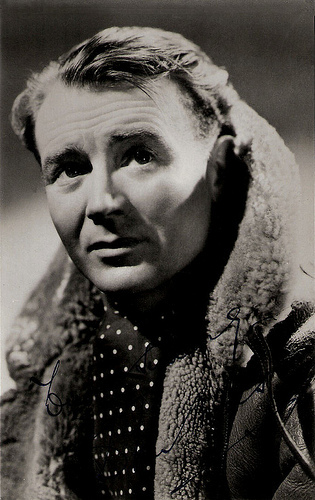
British autograph card. Photo: publicity still for The Way to the Stars (Anthony Asquith, 1945).

British postcard by Rotary Photo, London, no. F.S. 18. Caption: John Mills with his small daughter 'Bunch' in the studio. The picture was taken during the shooting of Great Expectations (David Lean, 1946). At the time, Juliet (or Bunch) must have been four years old. Juliet Mills is the elder sister of Hayley.
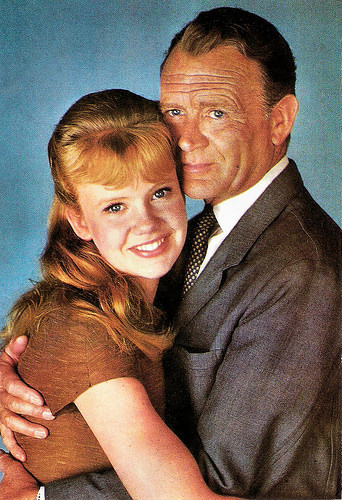
Spanish postcard by Postal Oscarcolor, no. 264. Publicity still for The Chalk Garden (Ronald Neame, 1964).
Juvenile Lead
Sir John Mills, CBE was born Lewis Ernest Watts Mills in the seaside resort North Elmham, England, in 1908. He was the son of Edith (Baker), a theatre box office manager, and Lewis Mills, a mathematics teacher. It was the stage world, rather than his father's academic milieu, which most attracted the young Mills.
After a job as a clerk in a corn merchant's office, Mills moved to London, where he enrolled at Zelia Raye's Dancing School. He started his professional career in 1929 as a chorus boy in the revue The Five O'clock Girl at the London Hippodrome. He followed this with a cabaret act.Making as many contacts as possible, Mills was able to secure work on the legitimate stage.
Mills got a job with a theatrical company that toured India, China and the Far East performing a number of plays. Noël Coward saw him appear in a production of Journey's End in Singapore and wrote Mills a letter of introduction to use back in London. On his return Mills starred in The 1931 Revue, Coward's Cavalcade (1931) and the Noël Coward revue Words and Music (1932).
His film debut was in the quota quickie The Midshipmaid (Albert de Courville, 1932), a comedy with musical interludes starring Jessie Matthews. The following years, he learned his craft in such 'quota quickies', low-cost, quickly-accomplished films commissioned by American distributors active in the UK or by British cinema owners to satisfy the quota requirements.
Next Mills was a juvenile lead in the mystery The Ghost Camera (Bernard Vorhaus, 1933) with Henry Kendall and Ida Lupino. Wikipedia: "Despite being made quickly on a low budget, the film has come to be considered as one of the most successful Quota quickies made during the Thirties."
He then played lead roles in the musical Charing Cross Road (Albert de Courville, 1935), Brown on Resolution (Walter Forde, 1935) with Betty Balfour , Tudor Rose (Robert Stevenson, 1936) starring Cedric Hardwicke and Nova Pilbeam , and The Green Cockatoo (William Cameron Menzies, 1937).
He did Aren't Men Beasts? (1936) on stage and worked for Hollywood director Raoul Walsh in O.H.M.S. (1937). His Hollywood debut was in Goodbye, Mr. Chips (Sam Wood, 1939) with Robert Donat , but he refused the American studios' entreaties to sign a contract and returned to England.
John Mills joined the army in 1939 but occasionally made films on leave, such as the comedy Old Bill and Son (Ian Dalrymple, 1940) and the war film Cottage to Let (Anthony Asquith, 1941) with Leslie Banks . He also appeared in the classic In Which We Serve (Noel Coward, David Lean, 1942).
He relished acting in films and the cinema made him an internationally renowned star. His climb to stardom began when he had the lead role in We Dive at Dawn (Anthony Asquith, 1943), a film about submariners. He was top billed in This Happy Breed (David Lean, 1944), directed by from a Noël Coward play. The film was a big hit and director David Lean would go on to direct Mills in some of his most memorable performances.
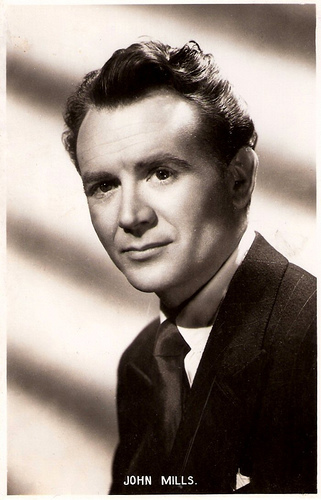
British Postcard, no. F. S. 23. Publicity photo for Scott of the Antarctic (1948).
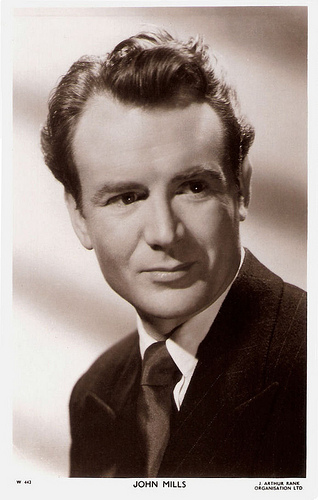
British postcard in the Picturegoer series, London, no. W 443. Photo: J. Arthur Rank Organisation Ltd.
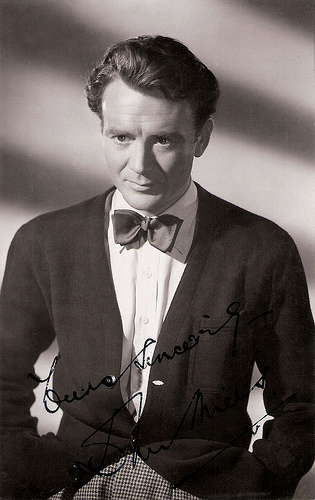
British postcard.
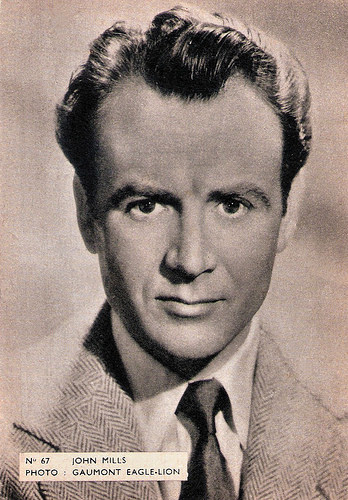
Belgian collectors card by Merbotex, no. 67. Photo: Gaumont Eagle-Lion.
Traditionally British Heroes
After the war, John Mills took the lead in Great Expectations (David Lean, 1946). It was the third biggest hit at the British box office this year and Mills was voted the sixth most popular star. Subsequently he had another big hit as Captain Robert Falcon Scott in Scott of the Antarctic (Charles Frend, 1948). It was the fourth most watched film of the year in Britain and Mills was the eighth biggest star.
Over the next decade he made his career playing other traditionally British heroes and became particularly associated with war dramas, such as The Colditz Story (Guy Hamilton, 1954), Above Us the Waves (Ralph Thomas, 1955) with John Gregson and Donald Sinden, and Ice Cold in Alex (J. Lee Thompson, 1958). He is credited with playing more military roles than any other star. In 31 of his films, almost a third of his whole cinematic output, he portrayed soldiers, usually officers.
David Lean directed Mills in a memorable performance in the romantic comedy Hobson's Choice (1954) with Charles Laughton . Other significant films in which he appeared include War and Peace (King Vidor, 1956), The Chalk Garden (Ronald Neame, 1964), King Rat (Bryan Forbes, 1965), and Oklahoma Crude (Stanley Kramer, 1973).
With his daughter Hayley Mills he also appeared in Tiger Bay (J. Lee Thompson, 1959) and The Family Way (Roy Boulting, 1966) and had a cameo in her Disney hit The Parent Trap (David Swift, 1961). In 1966, Mills directed Sky West and Crooked (aka Gypsy Girl), which starred Hayley and was written by his wife, Mary Hayley Bell.
As he aged, his proclivity for well-written roles enabled him to make a seamless transition from a lead to character lead to character actor. For his role as the village idiot in Ryan's Daughter (David Lean, 1970) — a complete departure from his usual style — he won the Oscar for Best Supporting Actor.
For Richard Attenborough, Mills played in Young Winston (1972) and Gandhi (1982), with Ben Kinsley. Among his last films were Bean (Mel Smith, 1997) starring Rowan Atkinson , Bright Young Things (Stephen Fry, 2003) and Lights2 (Marcus Dillistone, 2005), his final film appearance as a tramp.
Altogether he appeared in over 120 films. Jon C. Hopwood at IMDb : "No male star of English cinema enjoyed such a long and rewarding career as a star while appearing predominantly in English films. As an actor, Mills chose his roles on the basis of the quality of the script rather than its propriety as a 'star' turn. Because of this, he played roles that were more akin to character parts". Mills was appointed a Commander of the British Empire in 1960 and was knighted in 1976.
His first wife was the actress Aileen Raymond, (1932-1941). After their divorce, he married the dramatist Mary Hayley Bell. Their marriage, on 16 January 1941, lasted for 64 years, until his death in 2005. He was 97. Mills and Bell had two daughters, actresses Juliet and Hayley Mills and one son, Jonathan Mills, a screenwriter. His grandson is Crispian Mills, the lead singer of the pop group Kula Shaker. John Mills' life, both off screen and on, was summed up in his autobiography Up in the Clouds, Gentlemen, Please (1980).
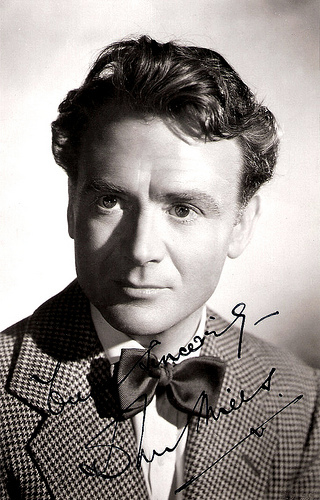
British autograph card.
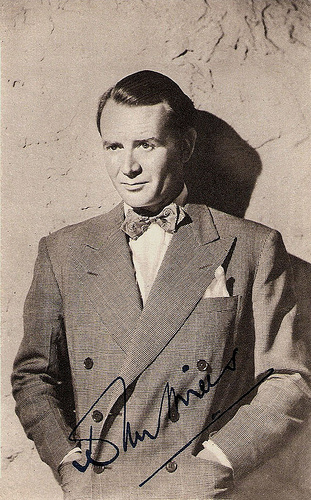
British postcard.
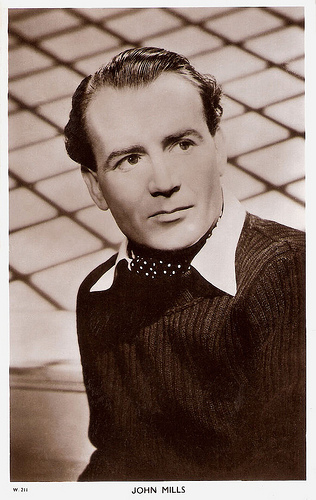
British postcard, no. W 211.
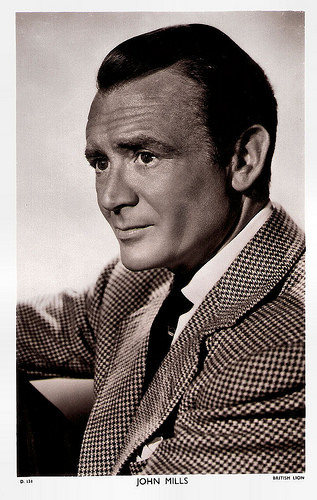
British postcard in the Picturegoer series, London, no. D 131. Photo: British Lion.
Sources: (IMDb), Hal Erickson (AllMovie), Wikipedia and .

British postcard by Real Photograph, no. 177. Photo: London Films.

British autograph card. Photo: publicity still for The Way to the Stars (Anthony Asquith, 1945).

British postcard by Rotary Photo, London, no. F.S. 18. Caption: John Mills with his small daughter 'Bunch' in the studio. The picture was taken during the shooting of Great Expectations (David Lean, 1946). At the time, Juliet (or Bunch) must have been four years old. Juliet Mills is the elder sister of Hayley.

Spanish postcard by Postal Oscarcolor, no. 264. Publicity still for The Chalk Garden (Ronald Neame, 1964).
Juvenile Lead
Sir John Mills, CBE was born Lewis Ernest Watts Mills in the seaside resort North Elmham, England, in 1908. He was the son of Edith (Baker), a theatre box office manager, and Lewis Mills, a mathematics teacher. It was the stage world, rather than his father's academic milieu, which most attracted the young Mills.
After a job as a clerk in a corn merchant's office, Mills moved to London, where he enrolled at Zelia Raye's Dancing School. He started his professional career in 1929 as a chorus boy in the revue The Five O'clock Girl at the London Hippodrome. He followed this with a cabaret act.Making as many contacts as possible, Mills was able to secure work on the legitimate stage.
Mills got a job with a theatrical company that toured India, China and the Far East performing a number of plays. Noël Coward saw him appear in a production of Journey's End in Singapore and wrote Mills a letter of introduction to use back in London. On his return Mills starred in The 1931 Revue, Coward's Cavalcade (1931) and the Noël Coward revue Words and Music (1932).
His film debut was in the quota quickie The Midshipmaid (Albert de Courville, 1932), a comedy with musical interludes starring Jessie Matthews. The following years, he learned his craft in such 'quota quickies', low-cost, quickly-accomplished films commissioned by American distributors active in the UK or by British cinema owners to satisfy the quota requirements.
Next Mills was a juvenile lead in the mystery The Ghost Camera (Bernard Vorhaus, 1933) with Henry Kendall and Ida Lupino. Wikipedia: "Despite being made quickly on a low budget, the film has come to be considered as one of the most successful Quota quickies made during the Thirties."
He then played lead roles in the musical Charing Cross Road (Albert de Courville, 1935), Brown on Resolution (Walter Forde, 1935) with Betty Balfour , Tudor Rose (Robert Stevenson, 1936) starring Cedric Hardwicke and Nova Pilbeam , and The Green Cockatoo (William Cameron Menzies, 1937).
He did Aren't Men Beasts? (1936) on stage and worked for Hollywood director Raoul Walsh in O.H.M.S. (1937). His Hollywood debut was in Goodbye, Mr. Chips (Sam Wood, 1939) with Robert Donat , but he refused the American studios' entreaties to sign a contract and returned to England.
John Mills joined the army in 1939 but occasionally made films on leave, such as the comedy Old Bill and Son (Ian Dalrymple, 1940) and the war film Cottage to Let (Anthony Asquith, 1941) with Leslie Banks . He also appeared in the classic In Which We Serve (Noel Coward, David Lean, 1942).
He relished acting in films and the cinema made him an internationally renowned star. His climb to stardom began when he had the lead role in We Dive at Dawn (Anthony Asquith, 1943), a film about submariners. He was top billed in This Happy Breed (David Lean, 1944), directed by from a Noël Coward play. The film was a big hit and director David Lean would go on to direct Mills in some of his most memorable performances.

British Postcard, no. F. S. 23. Publicity photo for Scott of the Antarctic (1948).

British postcard in the Picturegoer series, London, no. W 443. Photo: J. Arthur Rank Organisation Ltd.

British postcard.

Belgian collectors card by Merbotex, no. 67. Photo: Gaumont Eagle-Lion.
Traditionally British Heroes
After the war, John Mills took the lead in Great Expectations (David Lean, 1946). It was the third biggest hit at the British box office this year and Mills was voted the sixth most popular star. Subsequently he had another big hit as Captain Robert Falcon Scott in Scott of the Antarctic (Charles Frend, 1948). It was the fourth most watched film of the year in Britain and Mills was the eighth biggest star.
Over the next decade he made his career playing other traditionally British heroes and became particularly associated with war dramas, such as The Colditz Story (Guy Hamilton, 1954), Above Us the Waves (Ralph Thomas, 1955) with John Gregson and Donald Sinden, and Ice Cold in Alex (J. Lee Thompson, 1958). He is credited with playing more military roles than any other star. In 31 of his films, almost a third of his whole cinematic output, he portrayed soldiers, usually officers.
David Lean directed Mills in a memorable performance in the romantic comedy Hobson's Choice (1954) with Charles Laughton . Other significant films in which he appeared include War and Peace (King Vidor, 1956), The Chalk Garden (Ronald Neame, 1964), King Rat (Bryan Forbes, 1965), and Oklahoma Crude (Stanley Kramer, 1973).
With his daughter Hayley Mills he also appeared in Tiger Bay (J. Lee Thompson, 1959) and The Family Way (Roy Boulting, 1966) and had a cameo in her Disney hit The Parent Trap (David Swift, 1961). In 1966, Mills directed Sky West and Crooked (aka Gypsy Girl), which starred Hayley and was written by his wife, Mary Hayley Bell.
As he aged, his proclivity for well-written roles enabled him to make a seamless transition from a lead to character lead to character actor. For his role as the village idiot in Ryan's Daughter (David Lean, 1970) — a complete departure from his usual style — he won the Oscar for Best Supporting Actor.
For Richard Attenborough, Mills played in Young Winston (1972) and Gandhi (1982), with Ben Kinsley. Among his last films were Bean (Mel Smith, 1997) starring Rowan Atkinson , Bright Young Things (Stephen Fry, 2003) and Lights2 (Marcus Dillistone, 2005), his final film appearance as a tramp.
Altogether he appeared in over 120 films. Jon C. Hopwood at IMDb : "No male star of English cinema enjoyed such a long and rewarding career as a star while appearing predominantly in English films. As an actor, Mills chose his roles on the basis of the quality of the script rather than its propriety as a 'star' turn. Because of this, he played roles that were more akin to character parts". Mills was appointed a Commander of the British Empire in 1960 and was knighted in 1976.
His first wife was the actress Aileen Raymond, (1932-1941). After their divorce, he married the dramatist Mary Hayley Bell. Their marriage, on 16 January 1941, lasted for 64 years, until his death in 2005. He was 97. Mills and Bell had two daughters, actresses Juliet and Hayley Mills and one son, Jonathan Mills, a screenwriter. His grandson is Crispian Mills, the lead singer of the pop group Kula Shaker. John Mills' life, both off screen and on, was summed up in his autobiography Up in the Clouds, Gentlemen, Please (1980).

British autograph card.

British postcard.

British postcard, no. W 211.

British postcard in the Picturegoer series, London, no. D 131. Photo: British Lion.
Sources: (IMDb), Hal Erickson (AllMovie), Wikipedia and .
Published on March 21, 2018 23:00
March 20, 2018
Die Richterin (1917)
In the silent German melodrama Die Richterin/The Judge (Paul von Woringen, 1917), Lotte Neumann stars as a young woman who brings tragedy to her fiance and herself by being a moral judge. Neumann produced the film herself for her own company. The postcard series was published by the well-known Berlin firm Photochemie.
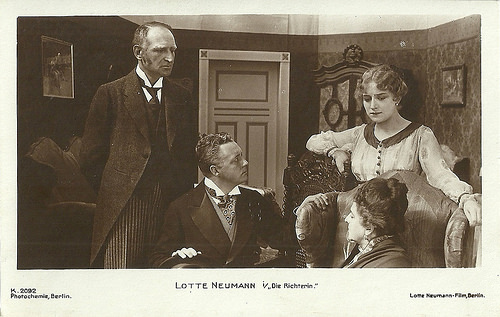
German postcard by Photochemie, Berlin, no K. 2092. Photo: Lotte Neumann-Film. Publicity still for Die Richterin/The Judge (Paul von Woringen, 1917).
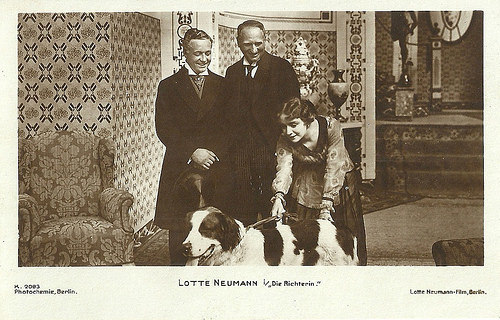
German postcard by Photochemie, Berlin, no K. 2093. Photo: Lotte Neumann-Film. Publicity still for Die Richterin/The Judge (Paul von Woringen, 1917).
A Moral Bride of Yore
Fritz Rönninger ( Carl Clewing ) owns a large printing works. One day, the businessman falls in love with his neighbour's daughter ( Lotte Neumann ), who was brought up in strict order by her father (Magnus Stifter).
Fritz turns out to be a kind and sincere candidate for her favour, and so one day the girl agrees to his request to marry him. Since Fritz does not want to go into marriage with a lie, he admits her a misstep, but one which took place a long time ago: in his youth he had once falsified a check and went to jail.
The strict paternal principles of custom and morality have turned Rönninger's future bride into a moral judge, and so she lets the upcoming marriage burst at the last moment.
Deeply saddened, Rönniger decides to give up his previous life completely. He sells his company and goes to Monaco with his new lover. There he leads a licentious life, probably only to numb his painful loss.
When he is finally broke, Fritz kills himself. In his farewell letter he blames his 'moral' bride of yore on his downfall. She had 'judged' him with her unforgiving morals. As she reads the letter, she realises her injustice towards Rönninger and also takes her life, by drowning herself.
Die Richterin was produced by Lotte Neumann herself and shot at the Mutoskop studio in Berlin-Lankwitz. It was the fourth part the Lotte Neumann-serie. The script was by Hans Land, pseudonym of Hugo Landsberger.
In October 1917 it was presented to the German Board of Censorship and quite soon after it was released. IMDb dates the film in 1918 because of the premiere of the film in Hungary on 28 January 1918.
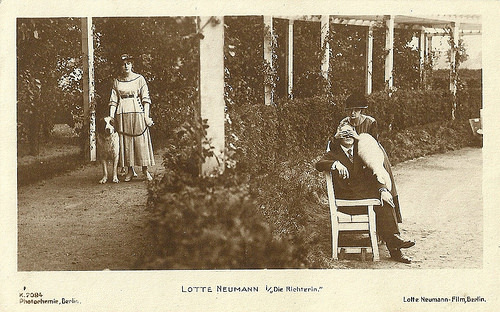
German postcard by Photochemie, Berlin, no K. 2094. Photo: Lotte Neumann-Film. Publicity still for Die Richterin/The Judge (Paul von Woringen, 1917).
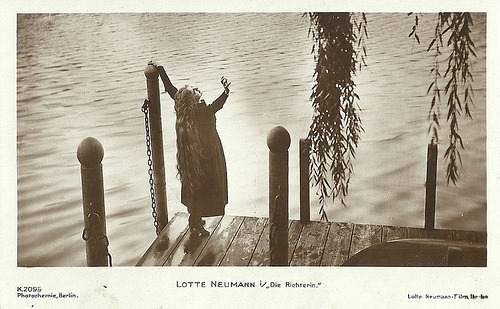
German postcard by Photochemie, Berlin, no K. 2095. Photo: Lotte Neumann-Film. Publicity still for Die Richterin/The Judge (Paul von Woringen, 1917).
Sources: Wikipedia (German), The German Early Cinema Database, Filmportal.de and IMDb.

German postcard by Photochemie, Berlin, no K. 2092. Photo: Lotte Neumann-Film. Publicity still for Die Richterin/The Judge (Paul von Woringen, 1917).

German postcard by Photochemie, Berlin, no K. 2093. Photo: Lotte Neumann-Film. Publicity still for Die Richterin/The Judge (Paul von Woringen, 1917).
A Moral Bride of Yore
Fritz Rönninger ( Carl Clewing ) owns a large printing works. One day, the businessman falls in love with his neighbour's daughter ( Lotte Neumann ), who was brought up in strict order by her father (Magnus Stifter).
Fritz turns out to be a kind and sincere candidate for her favour, and so one day the girl agrees to his request to marry him. Since Fritz does not want to go into marriage with a lie, he admits her a misstep, but one which took place a long time ago: in his youth he had once falsified a check and went to jail.
The strict paternal principles of custom and morality have turned Rönninger's future bride into a moral judge, and so she lets the upcoming marriage burst at the last moment.
Deeply saddened, Rönniger decides to give up his previous life completely. He sells his company and goes to Monaco with his new lover. There he leads a licentious life, probably only to numb his painful loss.
When he is finally broke, Fritz kills himself. In his farewell letter he blames his 'moral' bride of yore on his downfall. She had 'judged' him with her unforgiving morals. As she reads the letter, she realises her injustice towards Rönninger and also takes her life, by drowning herself.
Die Richterin was produced by Lotte Neumann herself and shot at the Mutoskop studio in Berlin-Lankwitz. It was the fourth part the Lotte Neumann-serie. The script was by Hans Land, pseudonym of Hugo Landsberger.
In October 1917 it was presented to the German Board of Censorship and quite soon after it was released. IMDb dates the film in 1918 because of the premiere of the film in Hungary on 28 January 1918.

German postcard by Photochemie, Berlin, no K. 2094. Photo: Lotte Neumann-Film. Publicity still for Die Richterin/The Judge (Paul von Woringen, 1917).

German postcard by Photochemie, Berlin, no K. 2095. Photo: Lotte Neumann-Film. Publicity still for Die Richterin/The Judge (Paul von Woringen, 1917).
Sources: Wikipedia (German), The German Early Cinema Database, Filmportal.de and IMDb.
Published on March 20, 2018 23:00
March 19, 2018
Luchino Visconti
Today, at the Royal Dutch institute in Rome, the presentation will take place of Reframing Luchino Visconti: film and art, a monograph written by EFSP-contributor Ivo Blom and published by Sidestone Press. This study deals with the ways in which Luchino Visconti appropriated visual arts and the cinema of previous filmmakers in his own films. Whilst much has been written about literary and theatrical influences upon Visconti’s work – besides film maker, he was also a leading theatre and opera director – there has been a lot of speculation about but little hard corroboration of pictorial influences in his films. Ivo's book goes deeply into set and costume design and cinematography. For today's post, we did a selection of our postcards of Visconti's films and stage plays.
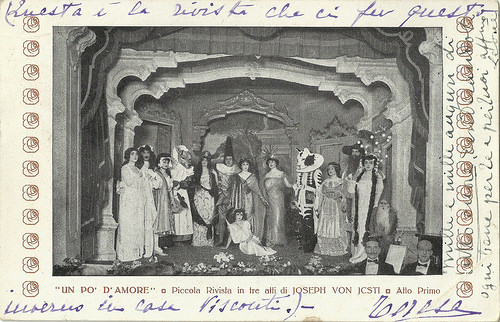
Italian postcard by Officine G. Ricordi e Co., Milano. Luchino Visconti (born 1906) was raised with theatre and staging from a very young age. His father, duke Giuseppe Visconti di Modrone, staged his own stage plays. Under the pseudonym of Joseph von Jcsti (Von Jcsti is an anagram of Visconti), he directed plays at his home theatre in Palazzo Visconti in Milan. This is a postcard for the play Un po' d'amore (A Little Love), a revue in three acts. A lady named Teresa writes on the card, that it is the revue she saw last winter in Casa Visconti. This must have been Winter 1912-1913, as the card is dated 2 September 1913.
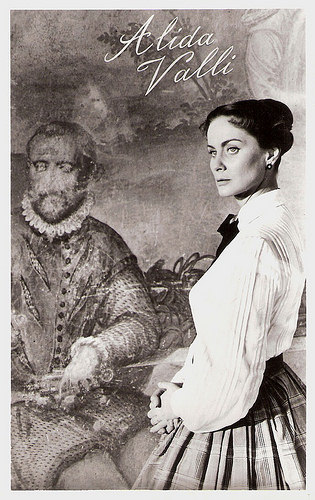
Dutch postcard by Takken, Utrecht, no. 1683. Photo: publicity still for Senso (Luchino Visconti, 1954) with Alida Valli . The picture was taken at Villa Godi Malinverni, Lugo di Vicenza, the first villa designed by Andrea Palladio. The murals were by painters from the School of Veronese.
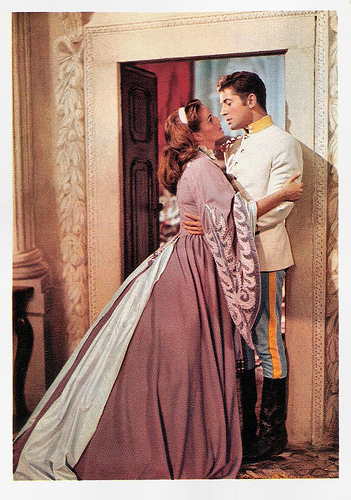
Italian postcard by Rotocalco Dagnino, Torino. Photo: Lux Film. Alida Valli and Farley Granger as countess Livia Serpieri and Lt. Franz Mahler in Luchino Visconti's historical film Senso (1954). Visconti refers here to the famous romantic painting by Francesco Hayez, Il Bacio (The Kiss, 1859).
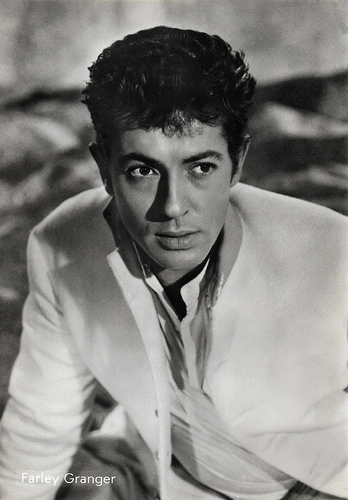
Italian postcard by Bromostampa, Milano, no. 7. Photo: Publicity still of Farley Granger in Senso (1954).
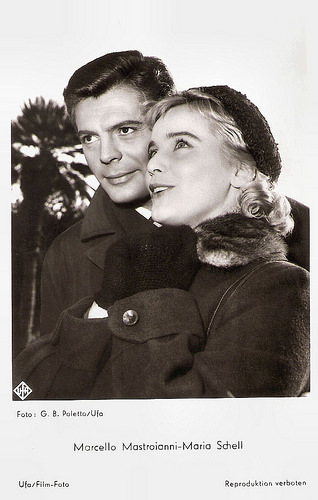
German postcard by Ufa, Berlin-Tempelhof, no. FK 3486. Photo: G.B. Poletto. Publicity still for Le notti bianche/ White Nights (Luchino Visconti, 1957) with Marcello Mastroianni and Maria Schell.
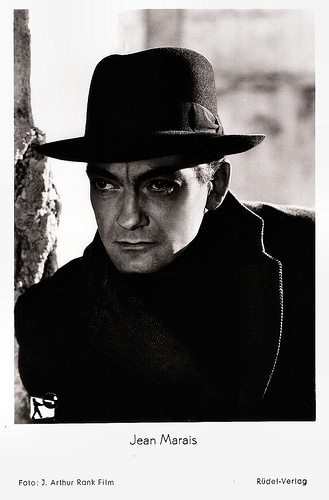
German postcard by Rüdel-Verlag, Hamburg-Bergedorf, no. 2141. Photo: J. Arthur Rank Film. Publicity still for Le notti bianche/ White Nights (Luchino Visconti, 1957) with Jean Marais .
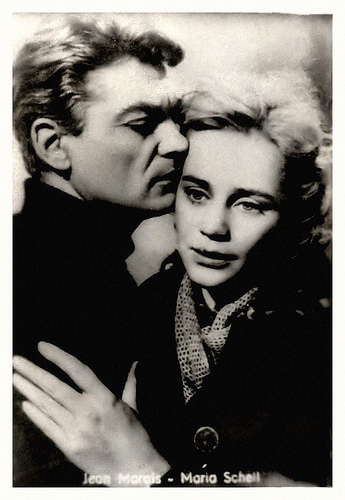
Photocard. Publicity still for Le notti bianche/ White Nights (Luchino Visconti, 1957) with Jean Marais and Maria Schell .
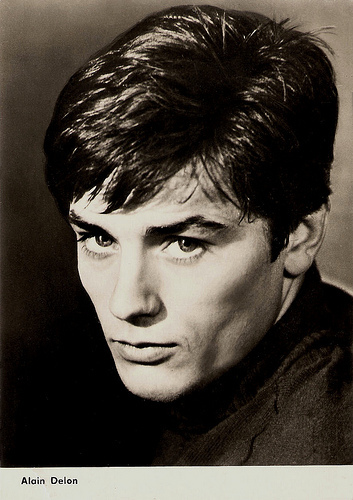
East-German postcard by VEB Progress Film-Vertrieb, Berlin, 1967. retail price: 0,20 MDN.Photo: publicity still for Rocco e i suoi fratelli/Rocco and His Brothers (Luchino Visconti, 1960), featuring Alain Delon as Rocco.
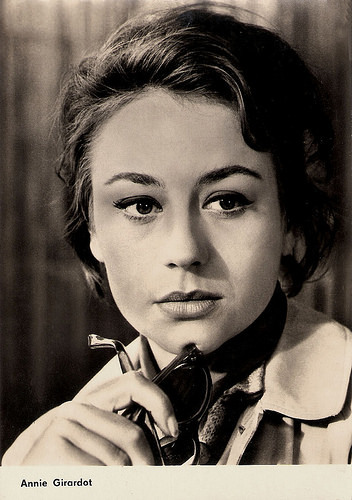
East-German postcard by VEB Progress Filmvertrieb, Berlin, no. 1696, 1962. Photo: publicity still for Rocco e i suoi fratelli/Rocco and his brothers (Luchino Visconti, 1960) with Annie Girardot as Nadia.
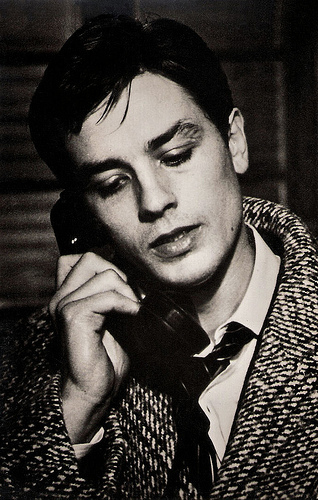
Spanish postcard by Archivo Bermejo, no. 7363. Photo: Radio Films, 1961. Publicity still for Rocco e i suoi fratelli/Rocco and His Brothers (Luchino Visconti, 1960) with Alain Delon .
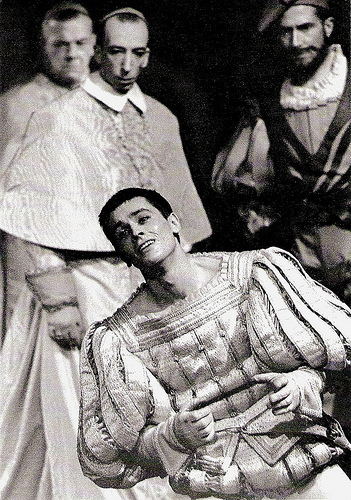
French postcard by the Bibliothèque Nationale Paris/Imp. Bussière A.G., Paris, 1990. Photo: Roger Pic. Alain Delon in the play Dommage qu'elle soit une p.../Its a pity she's a whore, written by John Ford and directed by Luchino Visconti (1961) in Paris.
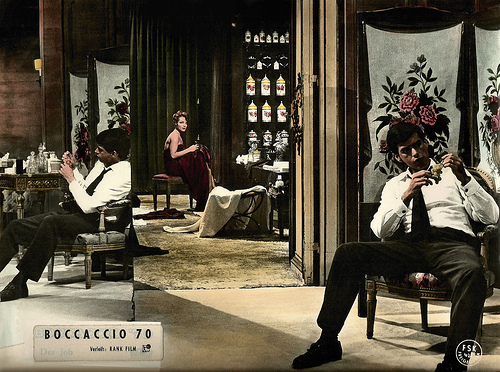
Publicity still used in Germany, distributed by Rank, mark of the German censor FSK. Tomas Milian and Romy Schneider in Luchino Visconti's episode Il lavoro in the episode film Boccaccio '70 (1962). Milian plays a bored aristocrat, caught in a scandal with callgirls. Schneider plays his rich and equally bored Austrian wife, who tries to seduce her husband and make him pay for love just like he did with his callgirls. It works, but leaves the woman with bitterness. The set of the film was terribly costly because of all the authentic, valuable objects present.
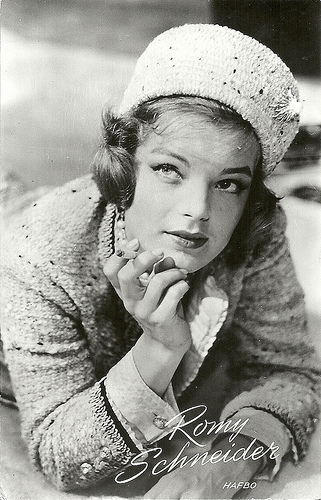
Dutch postcard. Photo: HAFBO. Romy Schneider dressed in Chanel in the episode Il lavoro/The Job (1961) by Luchino Visconti, part of the episodefilm Boccaccio '70. Schneider was a big fan of Chanel's fashion herself.
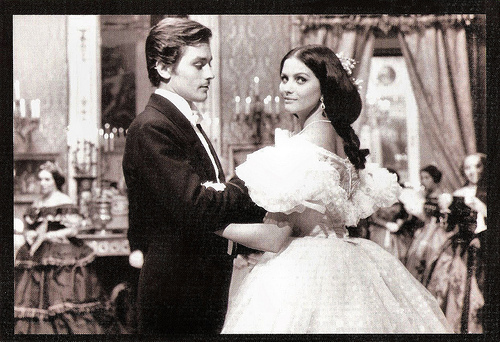
Vintage card. Photo: publicity still for Il Gattopardo/The Leopard (Luchino Visconti, 1963) with Alain Delon and Claudia Cardinale .
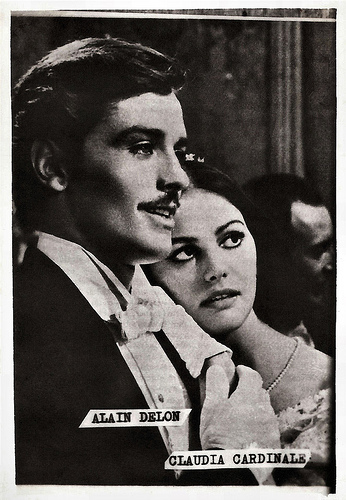
Small Romanian collectors card. Photo: publicity still for Il Gattopardo/The Leopard (Luchino Visconti, 1963) with Alain Delon and Claudia Cardinale .
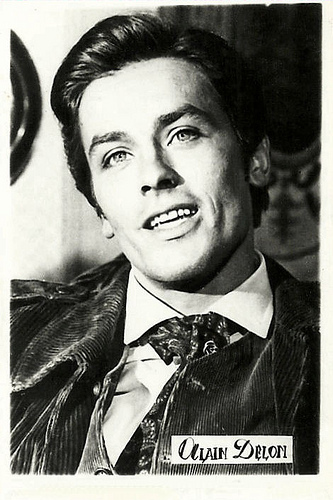
Small Romanian collectors card. Photo: Alain Delon as Tancredi Falconieri in Il Gattopardo/The Leopard (Luchino Visconti, 1963).
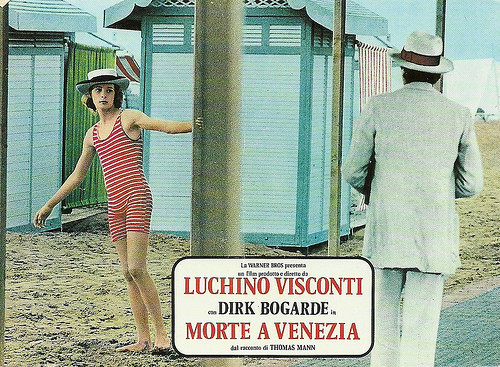
Dutch postcard, using an original poster of Morte a Venezia/Death in Venice, for a Dutch rerelease of the film. Photo: Björn Andresen and Dirk Bogarde in Morte a Venezia/Death in Venice (Luchino Visconti, 1972).
Reframing Luchino Visconti: film and art
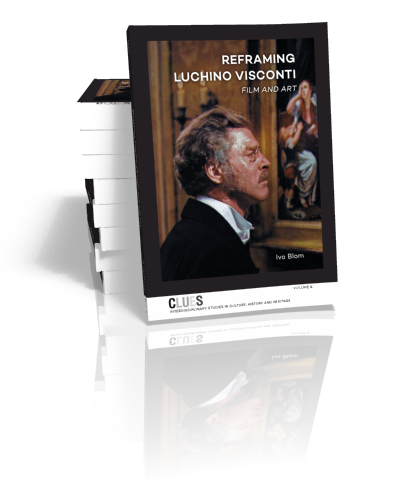 Where does the visual splendour of Visconti’s films come from? In the first part of his Reframing Luchino Visconti: film and art, Ivo Blom tells how visual arts (painting, sculpture, photography) served in set and costume design (e.g. as props and as sources of inspiration). The second part of the book focuses on (deep) staging, framing, mobile framing and mirroring.
Where does the visual splendour of Visconti’s films come from? In the first part of his Reframing Luchino Visconti: film and art, Ivo Blom tells how visual arts (painting, sculpture, photography) served in set and costume design (e.g. as props and as sources of inspiration). The second part of the book focuses on (deep) staging, framing, mobile framing and mirroring.
The book is based on extensive archival research, interviews with Visconti’s collaborators and secondary literature, and is richly illustrated with pictures obtained from museums, photo services and films.
Reframing Luchino Visconti: film and art will be released as paperback and hardback, and will also appear in Open Access. Highly recommended!
Sources: Ivo Blom (personal blog) and Sidestone Press.
Ivo, good luck today!

Italian postcard by Officine G. Ricordi e Co., Milano. Luchino Visconti (born 1906) was raised with theatre and staging from a very young age. His father, duke Giuseppe Visconti di Modrone, staged his own stage plays. Under the pseudonym of Joseph von Jcsti (Von Jcsti is an anagram of Visconti), he directed plays at his home theatre in Palazzo Visconti in Milan. This is a postcard for the play Un po' d'amore (A Little Love), a revue in three acts. A lady named Teresa writes on the card, that it is the revue she saw last winter in Casa Visconti. This must have been Winter 1912-1913, as the card is dated 2 September 1913.

Dutch postcard by Takken, Utrecht, no. 1683. Photo: publicity still for Senso (Luchino Visconti, 1954) with Alida Valli . The picture was taken at Villa Godi Malinverni, Lugo di Vicenza, the first villa designed by Andrea Palladio. The murals were by painters from the School of Veronese.

Italian postcard by Rotocalco Dagnino, Torino. Photo: Lux Film. Alida Valli and Farley Granger as countess Livia Serpieri and Lt. Franz Mahler in Luchino Visconti's historical film Senso (1954). Visconti refers here to the famous romantic painting by Francesco Hayez, Il Bacio (The Kiss, 1859).

Italian postcard by Bromostampa, Milano, no. 7. Photo: Publicity still of Farley Granger in Senso (1954).

German postcard by Ufa, Berlin-Tempelhof, no. FK 3486. Photo: G.B. Poletto. Publicity still for Le notti bianche/ White Nights (Luchino Visconti, 1957) with Marcello Mastroianni and Maria Schell.

German postcard by Rüdel-Verlag, Hamburg-Bergedorf, no. 2141. Photo: J. Arthur Rank Film. Publicity still for Le notti bianche/ White Nights (Luchino Visconti, 1957) with Jean Marais .

Photocard. Publicity still for Le notti bianche/ White Nights (Luchino Visconti, 1957) with Jean Marais and Maria Schell .

East-German postcard by VEB Progress Film-Vertrieb, Berlin, 1967. retail price: 0,20 MDN.Photo: publicity still for Rocco e i suoi fratelli/Rocco and His Brothers (Luchino Visconti, 1960), featuring Alain Delon as Rocco.

East-German postcard by VEB Progress Filmvertrieb, Berlin, no. 1696, 1962. Photo: publicity still for Rocco e i suoi fratelli/Rocco and his brothers (Luchino Visconti, 1960) with Annie Girardot as Nadia.

Spanish postcard by Archivo Bermejo, no. 7363. Photo: Radio Films, 1961. Publicity still for Rocco e i suoi fratelli/Rocco and His Brothers (Luchino Visconti, 1960) with Alain Delon .

French postcard by the Bibliothèque Nationale Paris/Imp. Bussière A.G., Paris, 1990. Photo: Roger Pic. Alain Delon in the play Dommage qu'elle soit une p.../Its a pity she's a whore, written by John Ford and directed by Luchino Visconti (1961) in Paris.

Publicity still used in Germany, distributed by Rank, mark of the German censor FSK. Tomas Milian and Romy Schneider in Luchino Visconti's episode Il lavoro in the episode film Boccaccio '70 (1962). Milian plays a bored aristocrat, caught in a scandal with callgirls. Schneider plays his rich and equally bored Austrian wife, who tries to seduce her husband and make him pay for love just like he did with his callgirls. It works, but leaves the woman with bitterness. The set of the film was terribly costly because of all the authentic, valuable objects present.

Dutch postcard. Photo: HAFBO. Romy Schneider dressed in Chanel in the episode Il lavoro/The Job (1961) by Luchino Visconti, part of the episodefilm Boccaccio '70. Schneider was a big fan of Chanel's fashion herself.

Vintage card. Photo: publicity still for Il Gattopardo/The Leopard (Luchino Visconti, 1963) with Alain Delon and Claudia Cardinale .

Small Romanian collectors card. Photo: publicity still for Il Gattopardo/The Leopard (Luchino Visconti, 1963) with Alain Delon and Claudia Cardinale .

Small Romanian collectors card. Photo: Alain Delon as Tancredi Falconieri in Il Gattopardo/The Leopard (Luchino Visconti, 1963).

Dutch postcard, using an original poster of Morte a Venezia/Death in Venice, for a Dutch rerelease of the film. Photo: Björn Andresen and Dirk Bogarde in Morte a Venezia/Death in Venice (Luchino Visconti, 1972).
Reframing Luchino Visconti: film and art
 Where does the visual splendour of Visconti’s films come from? In the first part of his Reframing Luchino Visconti: film and art, Ivo Blom tells how visual arts (painting, sculpture, photography) served in set and costume design (e.g. as props and as sources of inspiration). The second part of the book focuses on (deep) staging, framing, mobile framing and mirroring.
Where does the visual splendour of Visconti’s films come from? In the first part of his Reframing Luchino Visconti: film and art, Ivo Blom tells how visual arts (painting, sculpture, photography) served in set and costume design (e.g. as props and as sources of inspiration). The second part of the book focuses on (deep) staging, framing, mobile framing and mirroring.The book is based on extensive archival research, interviews with Visconti’s collaborators and secondary literature, and is richly illustrated with pictures obtained from museums, photo services and films.
Reframing Luchino Visconti: film and art will be released as paperback and hardback, and will also appear in Open Access. Highly recommended!
Sources: Ivo Blom (personal blog) and Sidestone Press.
Ivo, good luck today!
Published on March 19, 2018 23:00
March 18, 2018
Renate Blume
German actress Renate Blume (1944) appeared in more than 70 films and television shows since 1964. Her film debut Der geteilte Himmel/Divided Heaven (Konrad Wolf, 1964) was an international success and later she co-starred in Easterns with Gojko Mitic and Dean Reed.
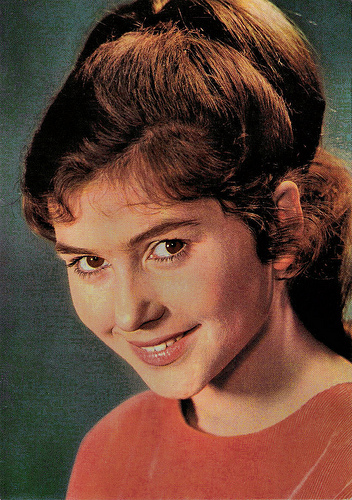
East-German postcard by VEB Progress Film-Vertrieb, no. 3538, 1966. Photo: DEFA / Schwarzer. Publicity still for Der geteilte Himmel/Divided Heaven (Konrad Wolf, 1964).

Big East-German card by VEB Progress Film-Vertrieb, no. 2/74, 1974. Photo: Linke.

With Dean Reed . Romanian postcard by Casa Filmului Acin, no. 43080.
Divided Heaven
Renate Blume was born in Bad Wildungen, Germany, in 1944. As a twelve-year-old she joined the Gret Palucca ballet school in Dresden. Although her parents wanted her to became a doctor, she secretly applied to the Academy for Performing Arts in Berlin.
While still a student, she played her first leading role in the DEFA drama Der geteilte Himmel/Divided Heaven (Konrad Wolf, 1964). The East-German film, based on Christa Wolf's novel Divided Heaven (1963), is set in the period immediately before the Berlin Wall was built.
Blume is Rita Seidel, who recalls the last two years, in which she fell in love with Manfred (Eberhard Esche), a chemist who is ten years older. As Manfred became disillusioned with his opportunities in East Germany, he moved to the West. Rita followed him there and tried to persuade him to return but soon realised he would never do it.
The film became an international success, thanks in part to Blume’s naturalistic and honest performance. Although some of the characters are shown as overzealous in their support of the regime, for obvious reasons the nature of the East German dictatorship is never depicted or discussed. The Stasi, the all-pervasive secret police headed by the director's brother Markus Wolf, is not mentioned.
The film was removed from circulation on several occasions in the following years, when the Socialist Unity Party of Germany decreed it, depending on the political situation In 1995, a group of historians and cinema researchers chose Der geteilte Himmel/Divided Heaven as one of the 100 most important German films ever made.
Three years later she appeared in the two-part war film Die gefrorenen Blitze/Frozen Flashes (János Veiczi, 1967) which tells the history of the resistance movement in Peenemünde during the Second World War and its attempt to sabotage the V-2 program. Among the large cast were also Alfred Müller, Leon Niemczyk and Mikhail Ulyanov. From 1965 to 1970, Blume was a member of the Dresdner Staatstheater ensemble, where she continued giving guest performances until 1986.
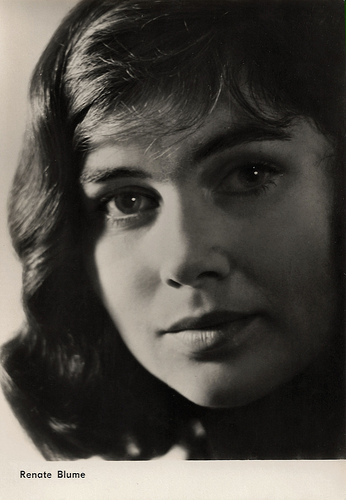
East-German postcard by VEB Progress Film-Vertrieb, no. 2.159, 1964. Photo: DEFA / Schwarzer. Publicity still for Der geteilte Himmel/Divided Heaven (Konrad Wolf, 1964).
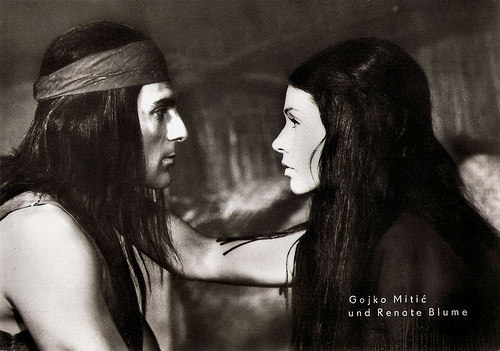
East-German postcard by VEB Progress Film-Vertrieb, no. 65/74, 1974. Photo: DEFA / Dassdorf. Publicity still for Ulzana (Gottfried Kolditz, 1974) with Gojko Mitic .
Ulzana
In 1970, Renate Blume joined the East German television ensemble and acted in over 40 TV productions over the next 20 years. Although Blume regularly appeared on TV, she rarely worked in the cinema.
In 1974, she co-starred in the Eastern Ulzana (Gottfried Kolditz, 1974), as the wife of Gojko Mitic ,the chief of the Mimbrero tribe. It was followed by the comic Eastern Kit & Co. (Konrad Petzold, 1974) with Dean Reed , an American actor, singer and songwriter, living in East Germany.
Blume appeared in Archiv des Todes/Archives of Death (1980). This 13-part East German war television series was set during World War II and also starred Gojko Mitic , Leon Niemczyk and Barbara Brylska.
In the cinema, Blume appeared in the fantasy Der Prinz hinter den sieben Meeren/The Prince of the Seven Seas (Walter Beck, 1982). After the Wende, Blume played a supporting part in the family film Die Distel/The Thistle (Gernot Krää, 1992) with Katja Riemann . In between she appeared in popular TV series such as Polizeiruf 110/Police Call 110 (1978-1998).
Since the Wall came down, she has taught performing arts, performed at theaters in Berlin, Dresden, Hamburg, and Munich, and acted in TV movies and TV series. In the cinema, she played a small part in the film Sternzeichen/Zodiac Sign (Peter Patzak, 2003) as the wife of Vadim Glowna. More recently she appeared in TV series such as Fünf Sterne/Five Stars (2005-2008) with Ralph Bauer, and Schloss Einstein (2008-2009) about students at a boarding school in Erfurt.
From 1969 until 1975 Blume was married with film director Frank Beyer. Their son Alexander also became an actor. From 1974 till 1976 she lived together with Romanian actor Gojko Mitic . In 1981, she married Dean Reed , but he died in 1986.
In 2007, Renate Blume was featured in Der Rote Elvis/The Red Elvis (2007), a German documentary about Reed’s life. Her most recent screen appearance was in the TV-Krimi Lindburgs Fall/Prime Time Crime (Franziska Meyer Price, 2011) with Fritz Wepper.
Sources: DEFA Film Library, Wikipedia (German and English) and .

East-German postcard by VEB Progress Film-Vertrieb, no. 3538, 1966. Photo: DEFA / Schwarzer. Publicity still for Der geteilte Himmel/Divided Heaven (Konrad Wolf, 1964).

Big East-German card by VEB Progress Film-Vertrieb, no. 2/74, 1974. Photo: Linke.

With Dean Reed . Romanian postcard by Casa Filmului Acin, no. 43080.
Divided Heaven
Renate Blume was born in Bad Wildungen, Germany, in 1944. As a twelve-year-old she joined the Gret Palucca ballet school in Dresden. Although her parents wanted her to became a doctor, she secretly applied to the Academy for Performing Arts in Berlin.
While still a student, she played her first leading role in the DEFA drama Der geteilte Himmel/Divided Heaven (Konrad Wolf, 1964). The East-German film, based on Christa Wolf's novel Divided Heaven (1963), is set in the period immediately before the Berlin Wall was built.
Blume is Rita Seidel, who recalls the last two years, in which she fell in love with Manfred (Eberhard Esche), a chemist who is ten years older. As Manfred became disillusioned with his opportunities in East Germany, he moved to the West. Rita followed him there and tried to persuade him to return but soon realised he would never do it.
The film became an international success, thanks in part to Blume’s naturalistic and honest performance. Although some of the characters are shown as overzealous in their support of the regime, for obvious reasons the nature of the East German dictatorship is never depicted or discussed. The Stasi, the all-pervasive secret police headed by the director's brother Markus Wolf, is not mentioned.
The film was removed from circulation on several occasions in the following years, when the Socialist Unity Party of Germany decreed it, depending on the political situation In 1995, a group of historians and cinema researchers chose Der geteilte Himmel/Divided Heaven as one of the 100 most important German films ever made.
Three years later she appeared in the two-part war film Die gefrorenen Blitze/Frozen Flashes (János Veiczi, 1967) which tells the history of the resistance movement in Peenemünde during the Second World War and its attempt to sabotage the V-2 program. Among the large cast were also Alfred Müller, Leon Niemczyk and Mikhail Ulyanov. From 1965 to 1970, Blume was a member of the Dresdner Staatstheater ensemble, where she continued giving guest performances until 1986.

East-German postcard by VEB Progress Film-Vertrieb, no. 2.159, 1964. Photo: DEFA / Schwarzer. Publicity still for Der geteilte Himmel/Divided Heaven (Konrad Wolf, 1964).

East-German postcard by VEB Progress Film-Vertrieb, no. 65/74, 1974. Photo: DEFA / Dassdorf. Publicity still for Ulzana (Gottfried Kolditz, 1974) with Gojko Mitic .
Ulzana
In 1970, Renate Blume joined the East German television ensemble and acted in over 40 TV productions over the next 20 years. Although Blume regularly appeared on TV, she rarely worked in the cinema.
In 1974, she co-starred in the Eastern Ulzana (Gottfried Kolditz, 1974), as the wife of Gojko Mitic ,the chief of the Mimbrero tribe. It was followed by the comic Eastern Kit & Co. (Konrad Petzold, 1974) with Dean Reed , an American actor, singer and songwriter, living in East Germany.
Blume appeared in Archiv des Todes/Archives of Death (1980). This 13-part East German war television series was set during World War II and also starred Gojko Mitic , Leon Niemczyk and Barbara Brylska.
In the cinema, Blume appeared in the fantasy Der Prinz hinter den sieben Meeren/The Prince of the Seven Seas (Walter Beck, 1982). After the Wende, Blume played a supporting part in the family film Die Distel/The Thistle (Gernot Krää, 1992) with Katja Riemann . In between she appeared in popular TV series such as Polizeiruf 110/Police Call 110 (1978-1998).
Since the Wall came down, she has taught performing arts, performed at theaters in Berlin, Dresden, Hamburg, and Munich, and acted in TV movies and TV series. In the cinema, she played a small part in the film Sternzeichen/Zodiac Sign (Peter Patzak, 2003) as the wife of Vadim Glowna. More recently she appeared in TV series such as Fünf Sterne/Five Stars (2005-2008) with Ralph Bauer, and Schloss Einstein (2008-2009) about students at a boarding school in Erfurt.
From 1969 until 1975 Blume was married with film director Frank Beyer. Their son Alexander also became an actor. From 1974 till 1976 she lived together with Romanian actor Gojko Mitic . In 1981, she married Dean Reed , but he died in 1986.
In 2007, Renate Blume was featured in Der Rote Elvis/The Red Elvis (2007), a German documentary about Reed’s life. Her most recent screen appearance was in the TV-Krimi Lindburgs Fall/Prime Time Crime (Franziska Meyer Price, 2011) with Fritz Wepper.
Sources: DEFA Film Library, Wikipedia (German and English) and .
Published on March 18, 2018 23:00
March 17, 2018
Ray Danton
American actor Ray Danton (1931-1992) was a handsome and smooth natured leading man who often played oily individuals in Hollywood film and TV series. He also worked in Europe where he directed some film too.
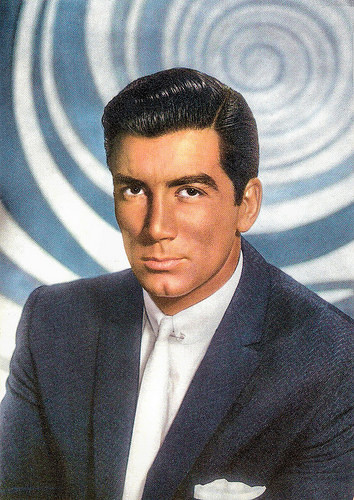
Italian postcard by Rotalcolor, Milano, no. N. 139.
A smooth but dangerous villain
Ray Danton was born Raymond Caplan in New York in 1931. Raymond was the son of Myrtle (née Menkin) and Jack Caplan. Danton entered show business as a child radio actor on NBC radio's Let's Pretend show in 1943.
Danton did many stage roles whilst attending the University of Pittsburgh. He was dramatically trained at Carnegie Tech and in 1950 went to London to appear on stage in the Tyrone Power production Mister Roberts. Danton's acting career was put on hold when he served in the United States Army infantry during the Korean War from 1951–1954.
His on-screen debut was as a moody Native American opposite Victor Mature in Chief Crazy Horse (George Sherman, 1955), a biography of the famous Lakota Sioux war chief which was told entirely from the Indian viewpoint. He was contracted to Universal Pictures.
He next played a supporting part as a smooth but dangerous villain in I'll Cry Tomorrow (Daniel Mann, 1955) starring Susan Hayward. For this part he won the Golden Globe as Most Promising Newcomer.
At the set of his third film for Universal The Looters (Abner Biberman, 1955) he met his future wife Julie Adams. Danton guest-starred in many 1950s TV shows including Playhouse 90 (1956), Wagon Train (1957), and 77 Sunset Strip (1958), often as a gunslinger or a slippery criminal.
Danton found plenty of demand for his talents and appeared in several minor films including the Film Noir The Night Runner (Abner Biberman,1957), the war film Tarawa Beachhead (Paul Wendkos, 1958), in which he starred with his wife, Julie Adams, and then as a serial rapist in The Beat Generation (Charles F. Haas, 1959) opposite Steve Cochran and Mamie van Doren .
However, his most well remembered role was as the vicious prohibition gangster Jack Diamond in The Rise and Fall of Legs Diamond (1960) also starring a young Warren Oates and directed by Budd Boetticher. Wikipedia : "Danton played his role using dynamic body language with his smooth persona fitting the character like a glove." Danton reprised his Legs Diamond role only a year later in the unrelated, and not as enjoyable Portrait of a Mobster (Joseph Pevney, 1961).
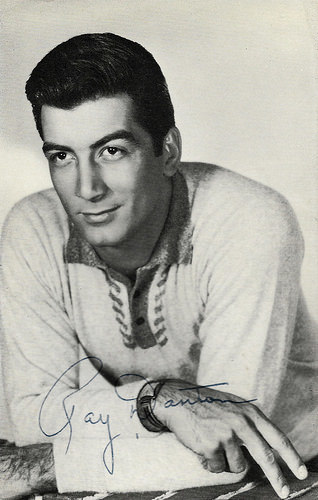
British postcard in the Celebrity Autograph Series by Celebrity Publishers LTD., London, no. 2789. Photo: Universal-International. Publicity still for The Night Runner (Abner Biberman, 1957).
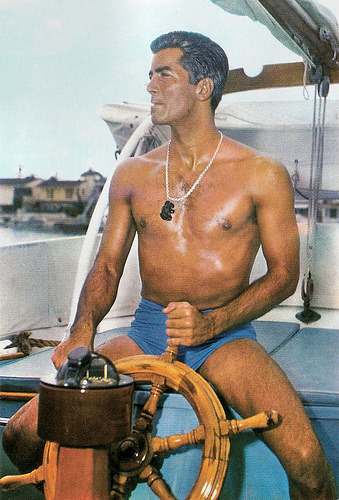
Spanish postcard by Raker, no. 1126.
Europe beckoned
Cornering the market on playing shady characters, Ray Danton then portrayed troubled actor George Raft in The George Raft Story (Joseph M. Newman, 1961) with Jayne Mansfield , but he was back on the side of good in 1962 playing an Allied officer at the invasion of Normandy in The Longest Day (Ken Annakin, Andrew Marton, Bernhard Wicki, 1962).
Europe then beckoned for the virile Danton, and like many other young US actors in the early 1960s, he made several films in Italy and Spain between 1964 and 1969 with a mixture of success. These films included Sandokan alla riscossa/Sandokan Fights Back (Luigi Capuano, 1964) with Guy Madison , and the Europsy films Corrida pour un espion/Code Name: Jaguar (Maurice Labro, 1965) with Pascale Petit, and New York chiama Superdrago/Secret Agent Super Dragon (Giorgio Ferroni, 1966) with Marisa Mell and Margaret Lee .
Danton returned to the USA in the early 1970s, but also ran his own production company in Barcelona, Spain. In Europe he directed the AIP production of Deathmaster (Ray Danton, 1972) starring Robert Quarry who was riding high on the success of the Count Yorga vampire films. Danton also co-directed La tumba de la isla maldita/Crypt of the Living Deads (Julio Salvador, Ray Danton, 1973) with Mark Damon.
Later he became involved in television and directed episodes of some of the most popular TV series of the 1970s and 1980s, including Quincy M.E. (1976), The Incredible Hulk (1978), Magnum, P.I. (1980), Dynasty (1981), and Cagney & Lacey (1981). His final directorial work was an episode for the TV series Mike Hammer (1989).
Ray Danton passed away in 1992 from kidney failure. He was only 61. He was divorced of his wife, Julie Adams, in 1978 ( IMDb ) or 1981 ( Wikipedia ). They had two sons, assistant director Steve Danton (1956) and editor Mitchell Danton (1962). His companion at the time of his death was actress Jeannie Austin, who was cast in a couple of TV episodes Ray directed, including Magnum, P.I. (1980).
Trailer for The George Raft Story (Joseph M. Newman, 1961). Source: horrormovieshows (YouTube).
Trailer for the EuroSpy adventure New York chiama Superdrago/Secret Agent Super Dragon (Giorgio Ferroni, 1966). Source: Night Of The Trailers (YouTube).
Sources: Wikipedia and .

Italian postcard by Rotalcolor, Milano, no. N. 139.
A smooth but dangerous villain
Ray Danton was born Raymond Caplan in New York in 1931. Raymond was the son of Myrtle (née Menkin) and Jack Caplan. Danton entered show business as a child radio actor on NBC radio's Let's Pretend show in 1943.
Danton did many stage roles whilst attending the University of Pittsburgh. He was dramatically trained at Carnegie Tech and in 1950 went to London to appear on stage in the Tyrone Power production Mister Roberts. Danton's acting career was put on hold when he served in the United States Army infantry during the Korean War from 1951–1954.
His on-screen debut was as a moody Native American opposite Victor Mature in Chief Crazy Horse (George Sherman, 1955), a biography of the famous Lakota Sioux war chief which was told entirely from the Indian viewpoint. He was contracted to Universal Pictures.
He next played a supporting part as a smooth but dangerous villain in I'll Cry Tomorrow (Daniel Mann, 1955) starring Susan Hayward. For this part he won the Golden Globe as Most Promising Newcomer.
At the set of his third film for Universal The Looters (Abner Biberman, 1955) he met his future wife Julie Adams. Danton guest-starred in many 1950s TV shows including Playhouse 90 (1956), Wagon Train (1957), and 77 Sunset Strip (1958), often as a gunslinger or a slippery criminal.
Danton found plenty of demand for his talents and appeared in several minor films including the Film Noir The Night Runner (Abner Biberman,1957), the war film Tarawa Beachhead (Paul Wendkos, 1958), in which he starred with his wife, Julie Adams, and then as a serial rapist in The Beat Generation (Charles F. Haas, 1959) opposite Steve Cochran and Mamie van Doren .
However, his most well remembered role was as the vicious prohibition gangster Jack Diamond in The Rise and Fall of Legs Diamond (1960) also starring a young Warren Oates and directed by Budd Boetticher. Wikipedia : "Danton played his role using dynamic body language with his smooth persona fitting the character like a glove." Danton reprised his Legs Diamond role only a year later in the unrelated, and not as enjoyable Portrait of a Mobster (Joseph Pevney, 1961).

British postcard in the Celebrity Autograph Series by Celebrity Publishers LTD., London, no. 2789. Photo: Universal-International. Publicity still for The Night Runner (Abner Biberman, 1957).

Spanish postcard by Raker, no. 1126.
Europe beckoned
Cornering the market on playing shady characters, Ray Danton then portrayed troubled actor George Raft in The George Raft Story (Joseph M. Newman, 1961) with Jayne Mansfield , but he was back on the side of good in 1962 playing an Allied officer at the invasion of Normandy in The Longest Day (Ken Annakin, Andrew Marton, Bernhard Wicki, 1962).
Europe then beckoned for the virile Danton, and like many other young US actors in the early 1960s, he made several films in Italy and Spain between 1964 and 1969 with a mixture of success. These films included Sandokan alla riscossa/Sandokan Fights Back (Luigi Capuano, 1964) with Guy Madison , and the Europsy films Corrida pour un espion/Code Name: Jaguar (Maurice Labro, 1965) with Pascale Petit, and New York chiama Superdrago/Secret Agent Super Dragon (Giorgio Ferroni, 1966) with Marisa Mell and Margaret Lee .
Danton returned to the USA in the early 1970s, but also ran his own production company in Barcelona, Spain. In Europe he directed the AIP production of Deathmaster (Ray Danton, 1972) starring Robert Quarry who was riding high on the success of the Count Yorga vampire films. Danton also co-directed La tumba de la isla maldita/Crypt of the Living Deads (Julio Salvador, Ray Danton, 1973) with Mark Damon.
Later he became involved in television and directed episodes of some of the most popular TV series of the 1970s and 1980s, including Quincy M.E. (1976), The Incredible Hulk (1978), Magnum, P.I. (1980), Dynasty (1981), and Cagney & Lacey (1981). His final directorial work was an episode for the TV series Mike Hammer (1989).
Ray Danton passed away in 1992 from kidney failure. He was only 61. He was divorced of his wife, Julie Adams, in 1978 ( IMDb ) or 1981 ( Wikipedia ). They had two sons, assistant director Steve Danton (1956) and editor Mitchell Danton (1962). His companion at the time of his death was actress Jeannie Austin, who was cast in a couple of TV episodes Ray directed, including Magnum, P.I. (1980).
Trailer for The George Raft Story (Joseph M. Newman, 1961). Source: horrormovieshows (YouTube).
Trailer for the EuroSpy adventure New York chiama Superdrago/Secret Agent Super Dragon (Giorgio Ferroni, 1966). Source: Night Of The Trailers (YouTube).
Sources: Wikipedia and .
Published on March 17, 2018 23:00
March 16, 2018
Oleg Tabakov (1935-2018)
On 12 March 2018,
Soviet and Russian actor Oleg Tabakov (1935) passed away. Tabakov performed in both classic and modern plays and was artistic director of the Moscow Art Theatre. His film career was equally impressive with roles as Count Nikita Rostov in Voyna i mir I/War and Peace (1966-1967) by Sergei Bondarchuk, and as the title figure in Oblomow (1981) by Nikita Mikhalkov. Tabakov was 82.
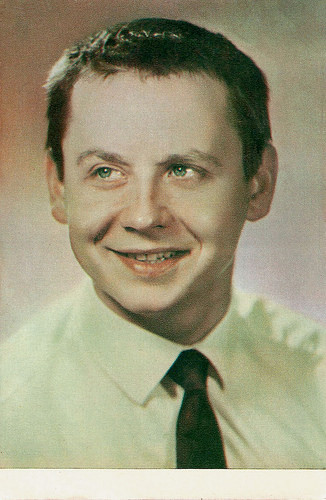
Russian postcard by Izdanije Byuro Propogandy Sovietskogo Kinoiskusstva, no. A 11212. Photo: B. Vilenkina, G. Ter-Ovanesova.
War and Peace
Oleg Pavlovich Tabakov (Russian: Олег Павлович Табаков) was born in Saratov, USSR (now Saratovskaya oblast, Russia) in 1935. His father, Pavel Kongratevich, and his mother, Maria Andreevna Berezovskaya, were medical doctors in Saratov. His parents separated during the Second World War, and young Tabakov was brought up by his single mother and grandmother.
Oleg attended the all-boys school in Saratov, and was active in the drama class. From 1950-1953 he studied acting at the Saratov House of Pioneers under the legendary acting coach Natalia Iosifivna Sukhostav. In 1953, Tabakov moved to Moscow and studied at the Moscow Art Theatre School.
In 1957 he graduated from the school, and became one of the founding fathers of the Sovremennik Theatre. There he played leading roles in such productions as Goly Korol (Naked King), Tri Zhelaniya (Three Wishes), Obyknovennaya istoriya (Ordinary story) and other contemporary Russian plays. From 1970 till 1976 Tabakov was General Manager of Sovremennik, he promoted Galina Volchek to Principal Director of the company.
He administrated the Sovremennik until 1982, when he moved to the Moscow Art Theatre, where he played Molière and Salieri for over 20 years. In 1986, Tabakov persuaded his students to form the Tabakov Studio attached to the Moscow Art Theatre. Several notable Russian actors including Yevgeny Mironov, Sergey Bezrukov, Vladimir Mashkov, Andrey Smolyakov and Alexandre Marine studied at the studio.
Tabakov also spread his theatre's ideals abroad. His teaching credentials include workshops and productions at the Paris Conservatoire, the British American Drama Academy, Akademie Der Künst in Hamburg, the Max Reinhardt Seminar in Vienna, Carnegie Mellon, The Juilliard School, New York University, Florida State University, The University of Delaware, and Harvard University.
For his stage work he won several medals an honours. Tabakov's film career paralleled his theatrical career. He made his film debut as Sasha in the drama Sasha vstupayet v zhizn/Sasha Enters Life (Mikhail Shvejtser, 1957). Soon followed roles in the crime drama Ispytatelnyy Srok/The Probation (Vladimir Gerasimov, 1960) and the war drama Chistoe nebo/Clear Skies (Grigori Chukhrai, 1961) with Yevgeni Urbansky . He appeared in the role of Nikolai Rostov in Sergei Bondarchuk 's Voyna i mir I/War and Peace (1966–1967),
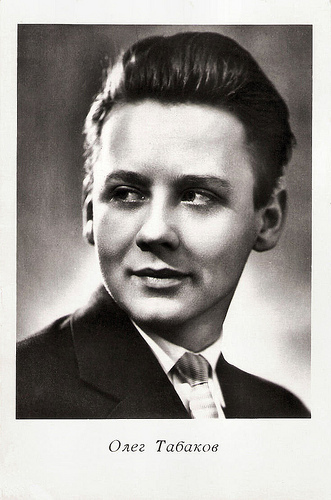
Russian postcard by Izdanije Byuro Propogandy Sovietskogo Kinoiskusstva, no. 3744, 1963.
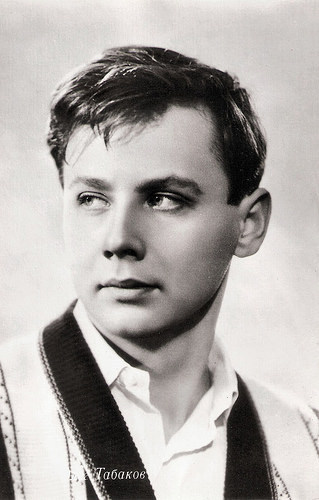
Russian postcard by Izdanije Byuro Propogandy Sovietskogo Kinoiskusstva, no. A 07154.
Moscow Does Not Believe In Tears
Oleg Tabakov played the lead role in the comedy-drama Gori, gori, moya zvezda/Shine, Shine, My Star (Aleksandr Mitta, 1970). Then followed parts in popular TV series as Semnadtsat mgnoveniy vesny/Seventeen Instants of Spring (Tatyana Lioznova, 1973), starring Vyacheslav Tikhonov, and D'Artanyan i tri mushketyora/D'Artagnan and Three Musketeers (Georgi Yungvald-Khilkevich, 1978).
An international success was Neokonchennaya pyesa dlya mekhanicheskogo pianino/An Unfinished Piece for a Piano Player (Nikita Mikhalkov, 1977). His later films include the Academy Award-winning Moskva slezam ne verit/Moscow Does Not Believe In Tears (Vladimir Menshov, 1980), the international art house hits Oblomov (Nikita Mikhalkov, 1981) and Oci ciornie/Dark Eyes (Nikita Mikhalkov, 1986) starring Marcello Mastroianni .
Tabakov also played in the mock slapstick Western Chelovek s bulvara Kaputsinov/A Man from the Boulevard des Capuchines (Alla Surikova, 1987) about Mr Jonny First (Andei Mironov), who arrives in the Wild West to present the art of the Cinematograph. Over 40 million people in the USSR paid to see the feature.
Tabakov has lend his distinctive, purr-like voice to a number of animated characters, including the talking cat Matroskin in the animation film Kanikuly v Prostokvashino/Three from Prostokvashino (Vladimir Popov, 1980) and its sequels. After the Matroskin role he dubbed the character of Garfield into Russian in the feature film Garfield (Peter Hewitt, 2004).
During the 1990s, Oleg Tabakov was a strong supporter of democratic reforms and freedom in the new Russia. He made public speeches and was involved in many public events facilitating the cultural transformation of arts and theatres in Russia. He also continued to appear in films, such as in The Inner Circle (Andrey Konchalovskiy, 1991), about Stalin's private film projectionist from (Tom Hulce), the TV movie Stalin (Ivan Passer, 1992) with Robert Duvall, and Taking Sides (István Szabó, 2001) with Harvey Keitel.
Oleg Tabakov was designated People's Actor of the USSR and Russia in the 1980s, and was decorated with the Order of Merit of Fatherland II degree, by the Russian president, Vladimir Putin, in 2005. During the 2012 Russian presidential election Tabakov was registered as a ‘Trusted Representative’ of Putin. In March 2014, he signed a letter in support of the position of Putin on Russia's military intervention in Ukraine.
His last films were the comedies Kukhnya v Parizhe/A Kitchen in Paris (Dmitriy Dyachenko, 2014) with Vincent Perez, and the sequel Kukhnya. Poslednyaya bitva/Kitchen. The Last Battle (Anton Fedotov, 2017).
In November 2017, Oleg Tabakov was hospitalised with sepsis. In December, Tabakov's condition deteriorated sharply - he fell into a pre-coma condition. On 12 March 2018, he died of a heart attack at age 82. The farewell ceremony took place at the Moscow Art Theatre named after Chekhov's historical stage where Tabakov worked as a artistic director and plays director for many years.
Oleg Tabakov was married twice. His first wife was actress Lyudmila Krylova (1960–1994) with whom he has two children. Their son Anton Tabakov is an actor and also a successful night-club owner in Moscow. Since 1994 Oleg Tabakov was married to actress Marina Zudina. The couple had two children, son Pavel (1996), and daughter Maria (2006).
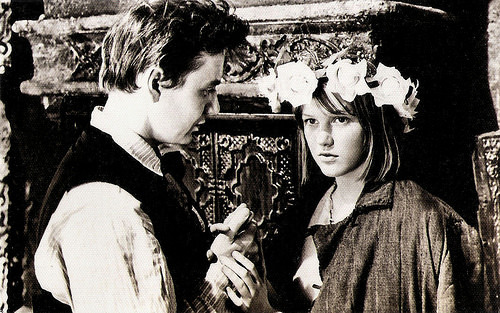
Russian postcard by Izdanije Byuro Propogandy Sovietskogo Kinoiskusstva, no. 1984. Publicity still for Gori, Gori, Moya Zvezda (Aleksandr Mitta, 1970) with Elena Proklova.
Sources: (IMDb), AllMovie, Wikipedia, and .

Russian postcard by Izdanije Byuro Propogandy Sovietskogo Kinoiskusstva, no. A 11212. Photo: B. Vilenkina, G. Ter-Ovanesova.
War and Peace
Oleg Pavlovich Tabakov (Russian: Олег Павлович Табаков) was born in Saratov, USSR (now Saratovskaya oblast, Russia) in 1935. His father, Pavel Kongratevich, and his mother, Maria Andreevna Berezovskaya, were medical doctors in Saratov. His parents separated during the Second World War, and young Tabakov was brought up by his single mother and grandmother.
Oleg attended the all-boys school in Saratov, and was active in the drama class. From 1950-1953 he studied acting at the Saratov House of Pioneers under the legendary acting coach Natalia Iosifivna Sukhostav. In 1953, Tabakov moved to Moscow and studied at the Moscow Art Theatre School.
In 1957 he graduated from the school, and became one of the founding fathers of the Sovremennik Theatre. There he played leading roles in such productions as Goly Korol (Naked King), Tri Zhelaniya (Three Wishes), Obyknovennaya istoriya (Ordinary story) and other contemporary Russian plays. From 1970 till 1976 Tabakov was General Manager of Sovremennik, he promoted Galina Volchek to Principal Director of the company.
He administrated the Sovremennik until 1982, when he moved to the Moscow Art Theatre, where he played Molière and Salieri for over 20 years. In 1986, Tabakov persuaded his students to form the Tabakov Studio attached to the Moscow Art Theatre. Several notable Russian actors including Yevgeny Mironov, Sergey Bezrukov, Vladimir Mashkov, Andrey Smolyakov and Alexandre Marine studied at the studio.
Tabakov also spread his theatre's ideals abroad. His teaching credentials include workshops and productions at the Paris Conservatoire, the British American Drama Academy, Akademie Der Künst in Hamburg, the Max Reinhardt Seminar in Vienna, Carnegie Mellon, The Juilliard School, New York University, Florida State University, The University of Delaware, and Harvard University.
For his stage work he won several medals an honours. Tabakov's film career paralleled his theatrical career. He made his film debut as Sasha in the drama Sasha vstupayet v zhizn/Sasha Enters Life (Mikhail Shvejtser, 1957). Soon followed roles in the crime drama Ispytatelnyy Srok/The Probation (Vladimir Gerasimov, 1960) and the war drama Chistoe nebo/Clear Skies (Grigori Chukhrai, 1961) with Yevgeni Urbansky . He appeared in the role of Nikolai Rostov in Sergei Bondarchuk 's Voyna i mir I/War and Peace (1966–1967),

Russian postcard by Izdanije Byuro Propogandy Sovietskogo Kinoiskusstva, no. 3744, 1963.

Russian postcard by Izdanije Byuro Propogandy Sovietskogo Kinoiskusstva, no. A 07154.
Moscow Does Not Believe In Tears
Oleg Tabakov played the lead role in the comedy-drama Gori, gori, moya zvezda/Shine, Shine, My Star (Aleksandr Mitta, 1970). Then followed parts in popular TV series as Semnadtsat mgnoveniy vesny/Seventeen Instants of Spring (Tatyana Lioznova, 1973), starring Vyacheslav Tikhonov, and D'Artanyan i tri mushketyora/D'Artagnan and Three Musketeers (Georgi Yungvald-Khilkevich, 1978).
An international success was Neokonchennaya pyesa dlya mekhanicheskogo pianino/An Unfinished Piece for a Piano Player (Nikita Mikhalkov, 1977). His later films include the Academy Award-winning Moskva slezam ne verit/Moscow Does Not Believe In Tears (Vladimir Menshov, 1980), the international art house hits Oblomov (Nikita Mikhalkov, 1981) and Oci ciornie/Dark Eyes (Nikita Mikhalkov, 1986) starring Marcello Mastroianni .
Tabakov also played in the mock slapstick Western Chelovek s bulvara Kaputsinov/A Man from the Boulevard des Capuchines (Alla Surikova, 1987) about Mr Jonny First (Andei Mironov), who arrives in the Wild West to present the art of the Cinematograph. Over 40 million people in the USSR paid to see the feature.
Tabakov has lend his distinctive, purr-like voice to a number of animated characters, including the talking cat Matroskin in the animation film Kanikuly v Prostokvashino/Three from Prostokvashino (Vladimir Popov, 1980) and its sequels. After the Matroskin role he dubbed the character of Garfield into Russian in the feature film Garfield (Peter Hewitt, 2004).
During the 1990s, Oleg Tabakov was a strong supporter of democratic reforms and freedom in the new Russia. He made public speeches and was involved in many public events facilitating the cultural transformation of arts and theatres in Russia. He also continued to appear in films, such as in The Inner Circle (Andrey Konchalovskiy, 1991), about Stalin's private film projectionist from (Tom Hulce), the TV movie Stalin (Ivan Passer, 1992) with Robert Duvall, and Taking Sides (István Szabó, 2001) with Harvey Keitel.
Oleg Tabakov was designated People's Actor of the USSR and Russia in the 1980s, and was decorated with the Order of Merit of Fatherland II degree, by the Russian president, Vladimir Putin, in 2005. During the 2012 Russian presidential election Tabakov was registered as a ‘Trusted Representative’ of Putin. In March 2014, he signed a letter in support of the position of Putin on Russia's military intervention in Ukraine.
His last films were the comedies Kukhnya v Parizhe/A Kitchen in Paris (Dmitriy Dyachenko, 2014) with Vincent Perez, and the sequel Kukhnya. Poslednyaya bitva/Kitchen. The Last Battle (Anton Fedotov, 2017).
In November 2017, Oleg Tabakov was hospitalised with sepsis. In December, Tabakov's condition deteriorated sharply - he fell into a pre-coma condition. On 12 March 2018, he died of a heart attack at age 82. The farewell ceremony took place at the Moscow Art Theatre named after Chekhov's historical stage where Tabakov worked as a artistic director and plays director for many years.
Oleg Tabakov was married twice. His first wife was actress Lyudmila Krylova (1960–1994) with whom he has two children. Their son Anton Tabakov is an actor and also a successful night-club owner in Moscow. Since 1994 Oleg Tabakov was married to actress Marina Zudina. The couple had two children, son Pavel (1996), and daughter Maria (2006).

Russian postcard by Izdanije Byuro Propogandy Sovietskogo Kinoiskusstva, no. 1984. Publicity still for Gori, Gori, Moya Zvezda (Aleksandr Mitta, 1970) with Elena Proklova.
Sources: (IMDb), AllMovie, Wikipedia, and .
Published on March 16, 2018 23:00
March 15, 2018
Cox
In Belgium a series of film star cards was published by Cox, an Import-Export firm. The series was produced in the 1950s and is remarkable because the cards have pictures at both sides. At the front is a colour picture of the star and the flipside shows a photo in black and white. Many of the stars were German, but there are also French, British and American artists in the series. In this post we show mainly the colour pictures, but also a few of the black and white sides.
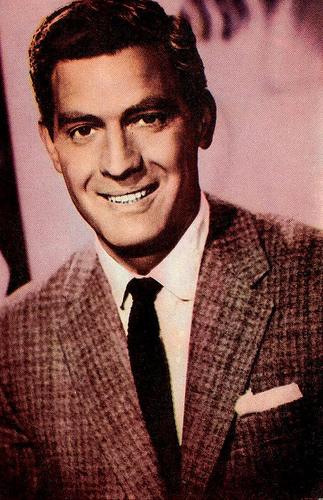
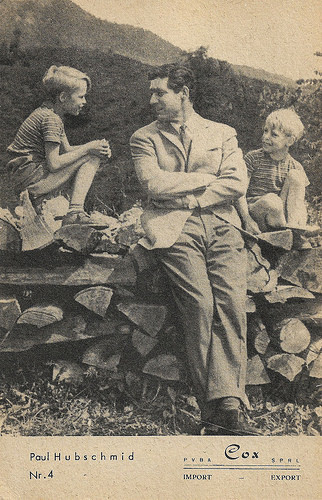
Paul Hubschmid . Belgian card by Cox, no. 4.
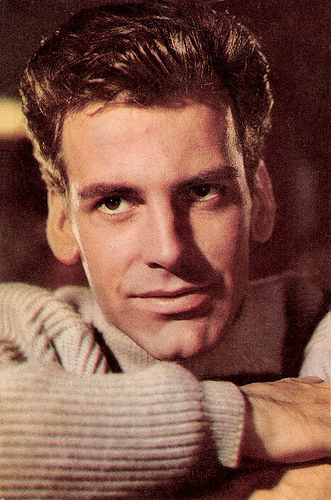
Maximilian Schell . Belgian card by Cox, no. 7.
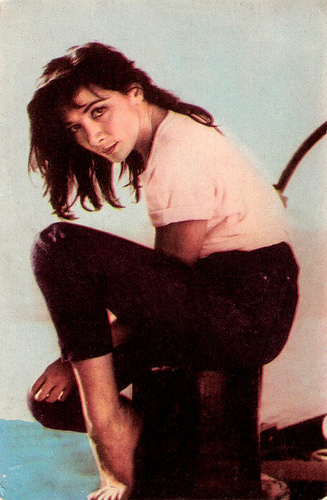
Juliette Gréco. Belgian card by Cox, no. 10.

Carlos Thompson . Belgian card by Cox, no. 18. Publicity still for Das Wirtshaus im Spessart/The Spessart Inn (Kurt Hoffmann, 1957).
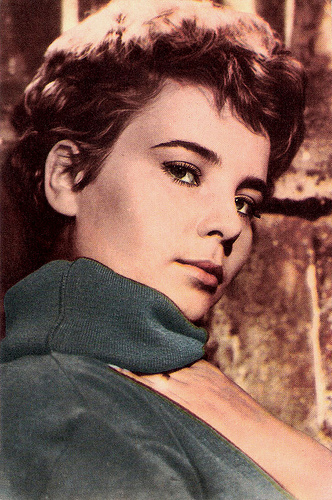
Corny Collins. Belgian card by Cox, no. 19.
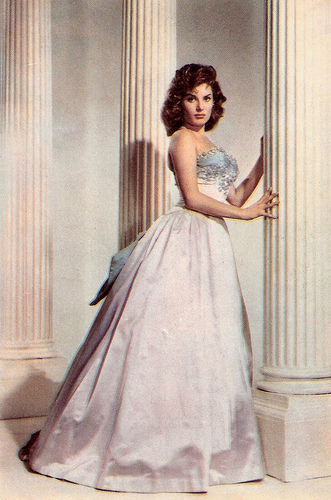
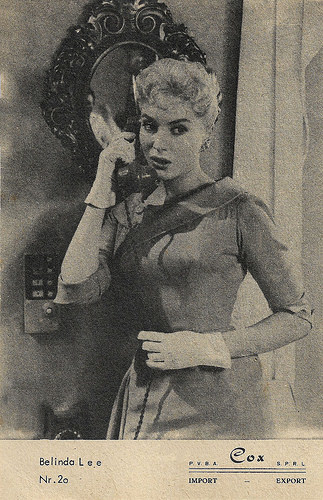
Belinda Lee . Belgian card by Cox, no. 20.
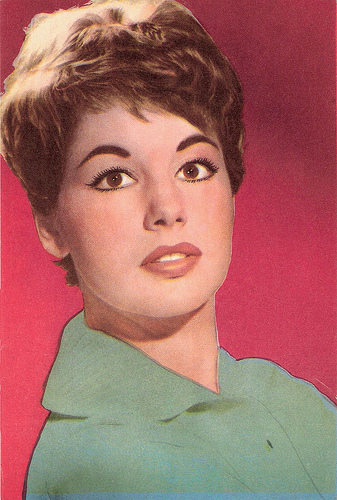
Johanna von Koczian . Belgian card by Cox, no. 23.
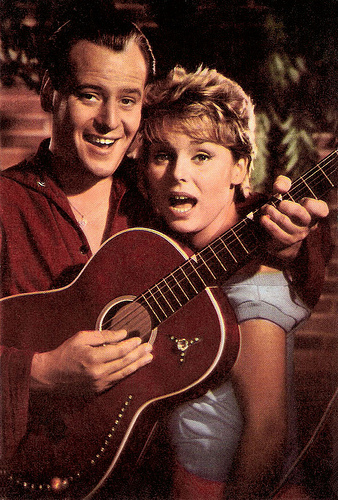
Fred Bertelmann and Conny Froboess . Belgian card by Cox, no. 25.
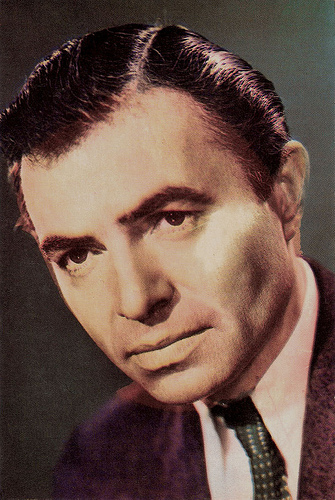
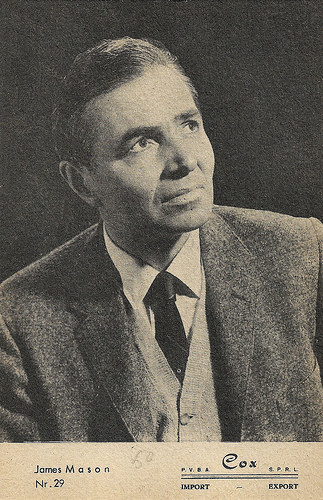
James Mason . Belgian card by Cox, no. 29.
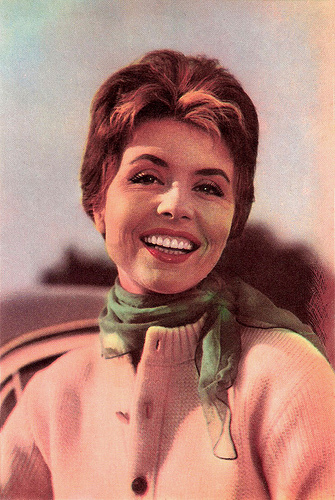
Sonja Ziemann . Belgian card by Cox, no. 33.
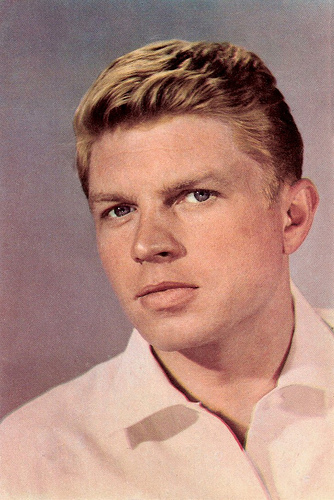
Hardy Krüger . Belgian card by Cox, no. 35.
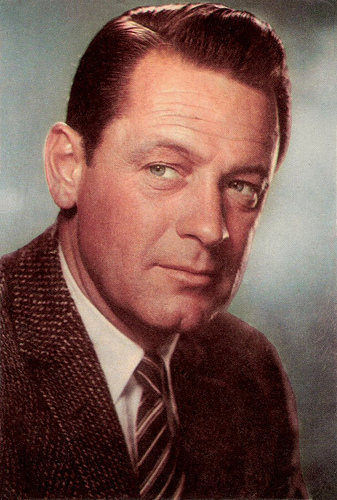
William Holden. Belgian card by Cox, no. 36.
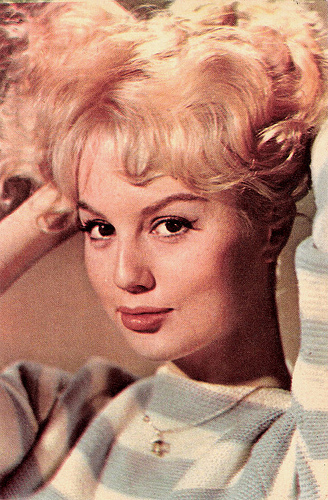
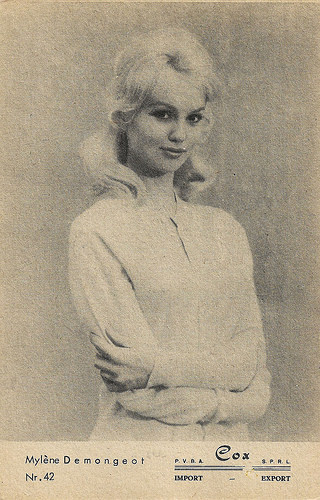
Mylène Demongeot . Belgian card by Cox, no. 42.
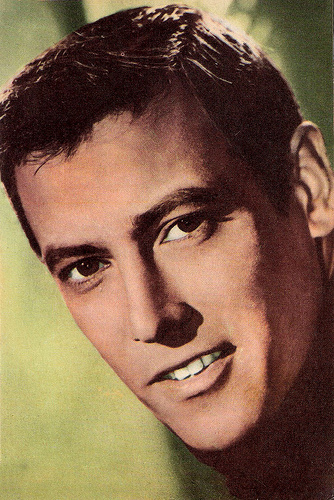
Dietmar Schönherr . Belgian postcard by Cox, no. 49.


Paul Hubschmid . Belgian card by Cox, no. 4.

Maximilian Schell . Belgian card by Cox, no. 7.

Juliette Gréco. Belgian card by Cox, no. 10.

Carlos Thompson . Belgian card by Cox, no. 18. Publicity still for Das Wirtshaus im Spessart/The Spessart Inn (Kurt Hoffmann, 1957).

Corny Collins. Belgian card by Cox, no. 19.


Belinda Lee . Belgian card by Cox, no. 20.

Johanna von Koczian . Belgian card by Cox, no. 23.

Fred Bertelmann and Conny Froboess . Belgian card by Cox, no. 25.


James Mason . Belgian card by Cox, no. 29.

Sonja Ziemann . Belgian card by Cox, no. 33.

Hardy Krüger . Belgian card by Cox, no. 35.

William Holden. Belgian card by Cox, no. 36.


Mylène Demongeot . Belgian card by Cox, no. 42.

Dietmar Schönherr . Belgian postcard by Cox, no. 49.
Published on March 15, 2018 23:00
March 14, 2018
Siegfried Rauch (1932-2018)
On 11 March 2018, popular German film and television actor Siegfried Rauch (1932) has died. In the 1970s, he appeared in several international films. He has been an actor for over 60 years, in approximately 200 productions, and remained active until his death. The 85-years-old Rauch died from injuries suffered when falling down stairs at a fire station near his home in Obersöchering near Munich.
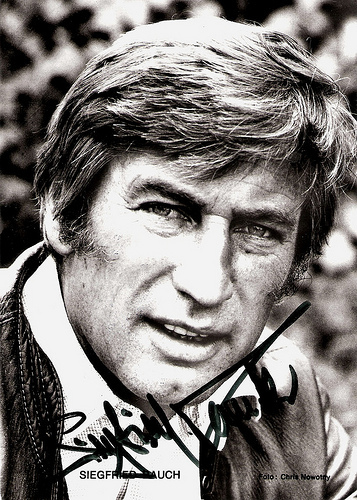
German postcard by Franz Josef Rüdel, Filmpostkartenverlag, Hamburg. Photo: Chris Nowotny, München.
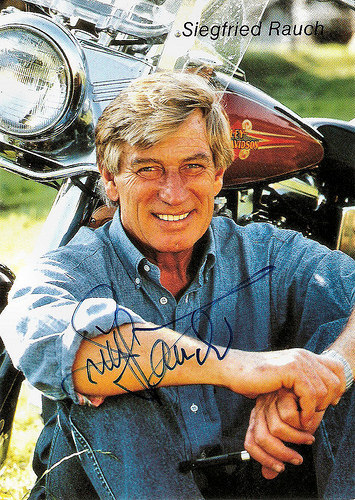
German promotion card by Süd Golf, Wolfratshausen.
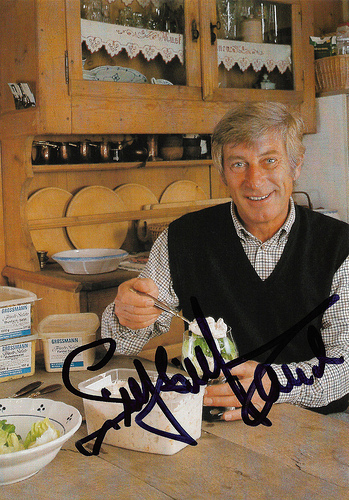
German autograph card by Firma Grossmann, Reinbek bei Hamburg.
Steve McQueen's rival
Siegfried Rauch was born in Landsberg am Lech, Germany, in 1932. Rauch studied drama at the Ludwig Maximilian University of Munich. Additionally, he attended private drama lessons. Since 1958, he has performed at different theatres, beginning with Bremen (until 1962), and followed by Berlin, Munich and Hamburg.
In 1956, he started his film career in the Heimatfilms Die Geierwally/Vulture Wally (Frantisek Cáp, 1956), starring Barbara Rütting and Carl Möhner , and Der Jäger von Fall/The Hunter of Fall (Gustav Ucicky, 1956), featuring Rudolf Lenz.
During the 1960s, he appeared in European coproductions like the Eurospy film Kommissar X - Drei gelbe Katzen/Death is Nimble, Death is Quick (Rudolf Zehetgruber, Gianfranco Parolini, 1966), starring Tony Kendall and Brad Harris . It is the second of seven films, loosely based on the Kommissar X #73 detective novel from the Pabel Moewig publishing house.
Another Eurospy film in which he played a supporting part was Mister Dynamit - Morgen küßt euch der Tod/Spy Today, Die Tomorrow (Franz Josef Gottlieb, 1967) starring Lex Barker and Maria Perschy . Rauch also appeared in the thriller Im Banne des Unheimlichen/The Zombie Walks (Alfred Vohrer, 1968) starring Joachim Fuchsberger . It is part of the series of German screen adaptations of Edgar Wallace's thriller novels.
In the 1970s Rauch often worked in Hollywood. He appeared opposite George C. Scott in the war epic Patton (Franklin J. Schaffner, 1970) as Captain Steiger. The film won seven Oscars, including Best Picture. In Le Mans (Lee H. Katzin, 1971), Rauch played the race driver Erich Stahler who is Steve McQueen's rival. Other Hollywood productions in which Rauch appeared were the war film The Eagle Has Landed (John Sturges, 1976) with Michael Caine , and Escape to Athena (George P. Cosmatos, 1979), starring Roger Moore and David Niven .
In Samuel Fuller's World War II war film The Big Red One (1980), Rauch played a German army sergeant, the opposite of Lee Marvin's character, who experiences the same events as Marvin only from a German perspective.
Mark Deming at AllMovie : “Unfortunately, Fuller was forced by his producers to work with a scaled-down budget, and he did not have final cut on the film; after his first rough cut ran nearly four-and-a-half hours, the studio took over editing on the project, and Fuller was vocally unhappy with the final results. In 2003, critic and film historian Richard Schickel initiated an effort to restore The Big Red One to a form that more closely resembled Fuller's original vision.“
Schickel's reconstruction received enthusiastic reviews when it went into limited release in the fall of 2004.
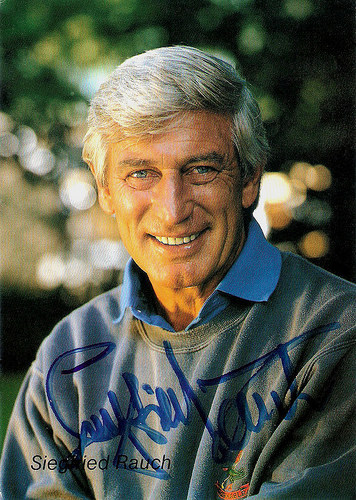
German autograph card.
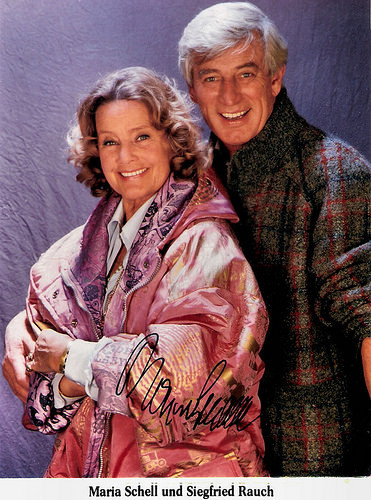
German autograph card. Publicity still for the TV series Die glückliche Familie/The Happy Family (1987-1991) with Maria Schell .
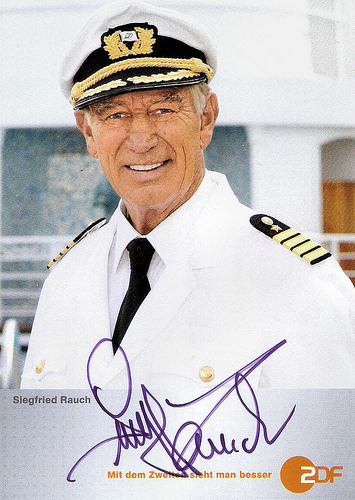
German autograph card by 2DF. Photo: ZDF / Dirk Bartling. Publicity still for the TV series Das Traumschiff/The Dream Boat (1997-2013).
It Can't Always Be Caviar
Siegfried Rauch continued to work in the German cinema and also on TV. He played in a new version of the Heimatfilm Der Jäger von Fall/The Hunter of Fall (Harald Reinl, 1974).
His most famous leading act on German television was Thomas Lieven in the mini-series Es muss nicht immer Kaviar sein/It Can't Always Be Caviar (Thomas Engel, 1977), based on the international bestseller by Johannes Mario Simmel. The series is unique for providing a little cooking show at the end of each episode. The book also includes recipes because Thomas Lieven is an accomplished amateur cook. The 13 episodes were very popular in Germany during the 1970s and 1980s, and have since attained cult-status.
Rauch’s various other roles on television established his career as an actor in Germany. Since 1997, Rauch has continuously appeared in Das Traumschiff/The Dreamboat (1997-2013), one of the most-watched television series in Germany. He also appeared in other long-running hit-series like Die Landärztin/The Country Doctor (2006-2011), the Das Traumschiff spin-off Kreuzfahrt ins Glück/Cruise to Happiness (2007-2013) and Der Bergdoktor/Mountain Medic (2008-2016, 96 episodes).
Internationally he appeared in films like the science fiction-horror film Contamination (Luigi Cozzi, 1980) starring Ian McCulloch, the action film Der Stein des Todes/Perahera, Death Stone (Franz Josef Gottlieb, 1985) and another actioner Feuer, Eis und Dynamit/Fire, Ice and Dynamite (Willy Bogner, 1990), starring Roger Moore .
Siegfried Rauch, also known as ‘Sigi’, died in 2018 as a result of a fall in his hometown of Untersochering, Bavaria. He was married to Karin and had two sons, Jakob and Benedikt, and one grandchild. Steve McQueen was the Godfather of his son Jakob.
Trailer Kommissar X - Drei gelbe Katzen/Death is Nimble, Death is Quick (1966). Source: Italo-Cinema Trailer (YouTube).
Trailer for Mister Dynamit - Morgen küßt euch der Tod/Spy Today, Die Tomorrow (1967). Source: Italo-Cinema Trailer (YouTube).
Trailer Le Mans (1971). Source: Umbrella Entertainment (YouTube).
Trailer The Big Red One (1980). Source: Video Detective (YouTube).
Sources: Mark Deming (AllMovie), Wikipedia (English and German), and .

German postcard by Franz Josef Rüdel, Filmpostkartenverlag, Hamburg. Photo: Chris Nowotny, München.

German promotion card by Süd Golf, Wolfratshausen.

German autograph card by Firma Grossmann, Reinbek bei Hamburg.
Steve McQueen's rival
Siegfried Rauch was born in Landsberg am Lech, Germany, in 1932. Rauch studied drama at the Ludwig Maximilian University of Munich. Additionally, he attended private drama lessons. Since 1958, he has performed at different theatres, beginning with Bremen (until 1962), and followed by Berlin, Munich and Hamburg.
In 1956, he started his film career in the Heimatfilms Die Geierwally/Vulture Wally (Frantisek Cáp, 1956), starring Barbara Rütting and Carl Möhner , and Der Jäger von Fall/The Hunter of Fall (Gustav Ucicky, 1956), featuring Rudolf Lenz.
During the 1960s, he appeared in European coproductions like the Eurospy film Kommissar X - Drei gelbe Katzen/Death is Nimble, Death is Quick (Rudolf Zehetgruber, Gianfranco Parolini, 1966), starring Tony Kendall and Brad Harris . It is the second of seven films, loosely based on the Kommissar X #73 detective novel from the Pabel Moewig publishing house.
Another Eurospy film in which he played a supporting part was Mister Dynamit - Morgen küßt euch der Tod/Spy Today, Die Tomorrow (Franz Josef Gottlieb, 1967) starring Lex Barker and Maria Perschy . Rauch also appeared in the thriller Im Banne des Unheimlichen/The Zombie Walks (Alfred Vohrer, 1968) starring Joachim Fuchsberger . It is part of the series of German screen adaptations of Edgar Wallace's thriller novels.
In the 1970s Rauch often worked in Hollywood. He appeared opposite George C. Scott in the war epic Patton (Franklin J. Schaffner, 1970) as Captain Steiger. The film won seven Oscars, including Best Picture. In Le Mans (Lee H. Katzin, 1971), Rauch played the race driver Erich Stahler who is Steve McQueen's rival. Other Hollywood productions in which Rauch appeared were the war film The Eagle Has Landed (John Sturges, 1976) with Michael Caine , and Escape to Athena (George P. Cosmatos, 1979), starring Roger Moore and David Niven .
In Samuel Fuller's World War II war film The Big Red One (1980), Rauch played a German army sergeant, the opposite of Lee Marvin's character, who experiences the same events as Marvin only from a German perspective.
Mark Deming at AllMovie : “Unfortunately, Fuller was forced by his producers to work with a scaled-down budget, and he did not have final cut on the film; after his first rough cut ran nearly four-and-a-half hours, the studio took over editing on the project, and Fuller was vocally unhappy with the final results. In 2003, critic and film historian Richard Schickel initiated an effort to restore The Big Red One to a form that more closely resembled Fuller's original vision.“
Schickel's reconstruction received enthusiastic reviews when it went into limited release in the fall of 2004.

German autograph card.

German autograph card. Publicity still for the TV series Die glückliche Familie/The Happy Family (1987-1991) with Maria Schell .

German autograph card by 2DF. Photo: ZDF / Dirk Bartling. Publicity still for the TV series Das Traumschiff/The Dream Boat (1997-2013).
It Can't Always Be Caviar
Siegfried Rauch continued to work in the German cinema and also on TV. He played in a new version of the Heimatfilm Der Jäger von Fall/The Hunter of Fall (Harald Reinl, 1974).
His most famous leading act on German television was Thomas Lieven in the mini-series Es muss nicht immer Kaviar sein/It Can't Always Be Caviar (Thomas Engel, 1977), based on the international bestseller by Johannes Mario Simmel. The series is unique for providing a little cooking show at the end of each episode. The book also includes recipes because Thomas Lieven is an accomplished amateur cook. The 13 episodes were very popular in Germany during the 1970s and 1980s, and have since attained cult-status.
Rauch’s various other roles on television established his career as an actor in Germany. Since 1997, Rauch has continuously appeared in Das Traumschiff/The Dreamboat (1997-2013), one of the most-watched television series in Germany. He also appeared in other long-running hit-series like Die Landärztin/The Country Doctor (2006-2011), the Das Traumschiff spin-off Kreuzfahrt ins Glück/Cruise to Happiness (2007-2013) and Der Bergdoktor/Mountain Medic (2008-2016, 96 episodes).
Internationally he appeared in films like the science fiction-horror film Contamination (Luigi Cozzi, 1980) starring Ian McCulloch, the action film Der Stein des Todes/Perahera, Death Stone (Franz Josef Gottlieb, 1985) and another actioner Feuer, Eis und Dynamit/Fire, Ice and Dynamite (Willy Bogner, 1990), starring Roger Moore .
Siegfried Rauch, also known as ‘Sigi’, died in 2018 as a result of a fall in his hometown of Untersochering, Bavaria. He was married to Karin and had two sons, Jakob and Benedikt, and one grandchild. Steve McQueen was the Godfather of his son Jakob.
Trailer Kommissar X - Drei gelbe Katzen/Death is Nimble, Death is Quick (1966). Source: Italo-Cinema Trailer (YouTube).
Trailer for Mister Dynamit - Morgen küßt euch der Tod/Spy Today, Die Tomorrow (1967). Source: Italo-Cinema Trailer (YouTube).
Trailer Le Mans (1971). Source: Umbrella Entertainment (YouTube).
Trailer The Big Red One (1980). Source: Video Detective (YouTube).
Sources: Mark Deming (AllMovie), Wikipedia (English and German), and .
Published on March 14, 2018 23:00
Paul van Yperen's Blog
- Paul van Yperen's profile
- 13 followers
Paul van Yperen isn't a Goodreads Author
(yet),
but they
do have a blog,
so here are some recent posts imported from
their feed.



